Quick filters:
Byzantine empress irene Stock Photos and Images
 Solidus (Coin) of Empress Irene, 797/802, Byzantine, minted in Constantinople (now Istanbul), Constantinople, Gold, Diam. 2.2 cm, 4.46 g Stock Photohttps://www.alamy.com/image-license-details/?v=1https://www.alamy.com/solidus-coin-of-empress-irene-797802-byzantine-minted-in-constantinople-now-istanbul-constantinople-gold-diam-22-cm-446-g-image328664117.html
Solidus (Coin) of Empress Irene, 797/802, Byzantine, minted in Constantinople (now Istanbul), Constantinople, Gold, Diam. 2.2 cm, 4.46 g Stock Photohttps://www.alamy.com/image-license-details/?v=1https://www.alamy.com/solidus-coin-of-empress-irene-797802-byzantine-minted-in-constantinople-now-istanbul-constantinople-gold-diam-22-cm-446-g-image328664117.htmlRM2A2KXC5–Solidus (Coin) of Empress Irene, 797/802, Byzantine, minted in Constantinople (now Istanbul), Constantinople, Gold, Diam. 2.2 cm, 4.46 g
 Empress Irene / Irene of Athens / Irene Sarantapechaina 752-803. Wife of Leo IV and mother to Constantine VI. Acting regent of Byzantine Empire 797–802. Herbert Norris artist died 1950 - may require copyright clearance Stock Photohttps://www.alamy.com/image-license-details/?v=1https://www.alamy.com/stock-photo-empress-irene-irene-of-athens-irene-sarantapechaina-752-803-wife-of-83345102.html
Empress Irene / Irene of Athens / Irene Sarantapechaina 752-803. Wife of Leo IV and mother to Constantine VI. Acting regent of Byzantine Empire 797–802. Herbert Norris artist died 1950 - may require copyright clearance Stock Photohttps://www.alamy.com/image-license-details/?v=1https://www.alamy.com/stock-photo-empress-irene-irene-of-athens-irene-sarantapechaina-752-803-wife-of-83345102.htmlRMERGKEP–Empress Irene / Irene of Athens / Irene Sarantapechaina 752-803. Wife of Leo IV and mother to Constantine VI. Acting regent of Byzantine Empire 797–802. Herbert Norris artist died 1950 - may require copyright clearance
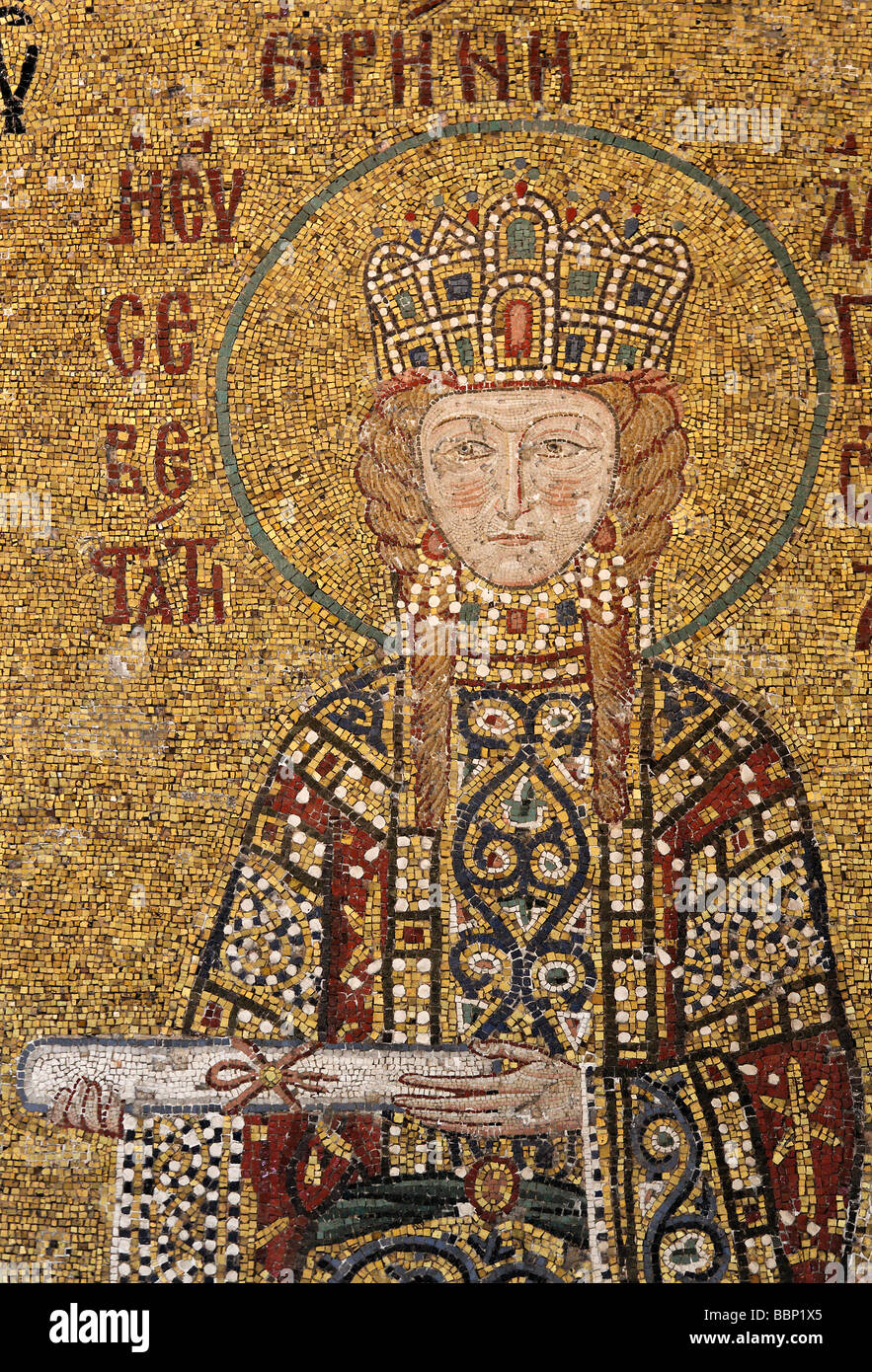 Empress Irene, Byzantine mosaic, South Gallery, Hagia Sophia, Aya Sofya, Sultanahmet, Istanbul, Turkey Stock Photohttps://www.alamy.com/image-license-details/?v=1https://www.alamy.com/stock-photo-empress-irene-byzantine-mosaic-south-gallery-hagia-sophia-aya-sofya-24456045.html
Empress Irene, Byzantine mosaic, South Gallery, Hagia Sophia, Aya Sofya, Sultanahmet, Istanbul, Turkey Stock Photohttps://www.alamy.com/image-license-details/?v=1https://www.alamy.com/stock-photo-empress-irene-byzantine-mosaic-south-gallery-hagia-sophia-aya-sofya-24456045.htmlRMBBP1X5–Empress Irene, Byzantine mosaic, South Gallery, Hagia Sophia, Aya Sofya, Sultanahmet, Istanbul, Turkey
 Byzantine Mosaic or Portrait of Byzantine Empress Irene of Athens (c752-803) reigned 797-802, in the South Gallery of Hagia Sophia Church Museum, Sultanahmet, Istanbul, Turkey Stock Photohttps://www.alamy.com/image-license-details/?v=1https://www.alamy.com/stock-photo-byzantine-mosaic-or-portrait-of-byzantine-empress-irene-of-athens-172320128.html
Byzantine Mosaic or Portrait of Byzantine Empress Irene of Athens (c752-803) reigned 797-802, in the South Gallery of Hagia Sophia Church Museum, Sultanahmet, Istanbul, Turkey Stock Photohttps://www.alamy.com/image-license-details/?v=1https://www.alamy.com/stock-photo-byzantine-mosaic-or-portrait-of-byzantine-empress-irene-of-athens-172320128.htmlRMM09T28–Byzantine Mosaic or Portrait of Byzantine Empress Irene of Athens (c752-803) reigned 797-802, in the South Gallery of Hagia Sophia Church Museum, Sultanahmet, Istanbul, Turkey
 Byzantine Empress Irene and Emperor Constantine VI. Irene of Athens, Irene Sarantapechaina, 752-803, and son Constantinus, Konstantinus, 771-805. Copperplate engraving from Abraham Bogaert’s De Roomsche Monarchy, The Roman Monarchy, Francois Salma, Utrecht, 1697. Stock Photohttps://www.alamy.com/image-license-details/?v=1https://www.alamy.com/byzantine-empress-irene-and-emperor-constantine-vi-irene-of-athens-irene-sarantapechaina-752-803-and-son-constantinus-konstantinus-771-805-copperplate-engraving-from-abraham-bogaerts-de-roomsche-monarchy-the-roman-monarchy-francois-salma-utrecht-1697-image329474666.html
Byzantine Empress Irene and Emperor Constantine VI. Irene of Athens, Irene Sarantapechaina, 752-803, and son Constantinus, Konstantinus, 771-805. Copperplate engraving from Abraham Bogaert’s De Roomsche Monarchy, The Roman Monarchy, Francois Salma, Utrecht, 1697. Stock Photohttps://www.alamy.com/image-license-details/?v=1https://www.alamy.com/byzantine-empress-irene-and-emperor-constantine-vi-irene-of-athens-irene-sarantapechaina-752-803-and-son-constantinus-konstantinus-771-805-copperplate-engraving-from-abraham-bogaerts-de-roomsche-monarchy-the-roman-monarchy-francois-salma-utrecht-1697-image329474666.htmlRM2A40T8A–Byzantine Empress Irene and Emperor Constantine VI. Irene of Athens, Irene Sarantapechaina, 752-803, and son Constantinus, Konstantinus, 771-805. Copperplate engraving from Abraham Bogaert’s De Roomsche Monarchy, The Roman Monarchy, Francois Salma, Utrecht, 1697.
 Irene of Athens, Byzantine empress, copperplate engraving from Strahlheim, about 1840th., Artist's Copyright has not to be cleared Stock Photohttps://www.alamy.com/image-license-details/?v=1https://www.alamy.com/irene-of-athens-byzantine-empress-copperplate-engraving-from-strahlheim-about-1840th-artists-copyright-has-not-to-be-cleared-image238655473.html
Irene of Athens, Byzantine empress, copperplate engraving from Strahlheim, about 1840th., Artist's Copyright has not to be cleared Stock Photohttps://www.alamy.com/image-license-details/?v=1https://www.alamy.com/irene-of-athens-byzantine-empress-copperplate-engraving-from-strahlheim-about-1840th-artists-copyright-has-not-to-be-cleared-image238655473.htmlRMRT7KDN–Irene of Athens, Byzantine empress, copperplate engraving from Strahlheim, about 1840th., Artist's Copyright has not to be cleared
 Byzantine Empress Irene and Emperor Constantine VI. Irene of Athens, Irene Sarantapechaina, 752-803, and son Constantinus, Konstantinus, 771-805. Copperplate engraving from Abraham Bogaerts De Roomsche Monarchy, The Roman Monarchy, Francois Salma, Utrecht, 1697. Stock Photohttps://www.alamy.com/image-license-details/?v=1https://www.alamy.com/byzantine-empress-irene-and-emperor-constantine-vi-irene-of-athens-irene-sarantapechaina-752-803-and-son-constantinus-konstantinus-771-805-copperplate-engraving-from-abraham-bogaerts-de-roomsche-monarchy-the-roman-monarchy-francois-salma-utrecht-1697-image359068935.html
Byzantine Empress Irene and Emperor Constantine VI. Irene of Athens, Irene Sarantapechaina, 752-803, and son Constantinus, Konstantinus, 771-805. Copperplate engraving from Abraham Bogaerts De Roomsche Monarchy, The Roman Monarchy, Francois Salma, Utrecht, 1697. Stock Photohttps://www.alamy.com/image-license-details/?v=1https://www.alamy.com/byzantine-empress-irene-and-emperor-constantine-vi-irene-of-athens-irene-sarantapechaina-752-803-and-son-constantinus-konstantinus-771-805-copperplate-engraving-from-abraham-bogaerts-de-roomsche-monarchy-the-roman-monarchy-francois-salma-utrecht-1697-image359068935.htmlRM2BT502F–Byzantine Empress Irene and Emperor Constantine VI. Irene of Athens, Irene Sarantapechaina, 752-803, and son Constantinus, Konstantinus, 771-805. Copperplate engraving from Abraham Bogaerts De Roomsche Monarchy, The Roman Monarchy, Francois Salma, Utrecht, 1697.
 Mosaic of Emperor John II Comnenus, the Virgin Mary, and Empress Irene in Hagia Sophia, Istanbul created in 1118. This Byzantine masterpiece shows Emperor John II holding a purse, a symbol of generosity, and Empress Irene holding a scroll, signifying wisdom. The Virgin Mary, centered, holds the Christ child. The gold background signifies divinity and the heavenly realm. Stock Photohttps://www.alamy.com/image-license-details/?v=1https://www.alamy.com/mosaic-of-emperor-john-ii-comnenus-the-virgin-mary-and-empress-irene-in-hagia-sophia-istanbul-created-in-1118-this-byzantine-masterpiece-shows-emperor-john-ii-holding-a-purse-a-symbol-of-generosity-and-empress-irene-holding-a-scroll-signifying-wisdom-the-virgin-mary-centered-holds-the-christ-child-the-gold-background-signifies-divinity-and-the-heavenly-realm-image622873798.html
Mosaic of Emperor John II Comnenus, the Virgin Mary, and Empress Irene in Hagia Sophia, Istanbul created in 1118. This Byzantine masterpiece shows Emperor John II holding a purse, a symbol of generosity, and Empress Irene holding a scroll, signifying wisdom. The Virgin Mary, centered, holds the Christ child. The gold background signifies divinity and the heavenly realm. Stock Photohttps://www.alamy.com/image-license-details/?v=1https://www.alamy.com/mosaic-of-emperor-john-ii-comnenus-the-virgin-mary-and-empress-irene-in-hagia-sophia-istanbul-created-in-1118-this-byzantine-masterpiece-shows-emperor-john-ii-holding-a-purse-a-symbol-of-generosity-and-empress-irene-holding-a-scroll-signifying-wisdom-the-virgin-mary-centered-holds-the-christ-child-the-gold-background-signifies-divinity-and-the-heavenly-realm-image622873798.htmlRM2Y5A9TP–Mosaic of Emperor John II Comnenus, the Virgin Mary, and Empress Irene in Hagia Sophia, Istanbul created in 1118. This Byzantine masterpiece shows Emperor John II holding a purse, a symbol of generosity, and Empress Irene holding a scroll, signifying wisdom. The Virgin Mary, centered, holds the Christ child. The gold background signifies divinity and the heavenly realm.
 Empress Irene (1088-1134). Byzantine empress. Mosaic of the South Gallery. Hagia Sophia. Istanbul. Turkey. Stock Photohttps://www.alamy.com/image-license-details/?v=1https://www.alamy.com/stock-photo-empress-irene-1088-1134-byzantine-empress-mosaic-of-the-south-gallery-43212178.html
Empress Irene (1088-1134). Byzantine empress. Mosaic of the South Gallery. Hagia Sophia. Istanbul. Turkey. Stock Photohttps://www.alamy.com/image-license-details/?v=1https://www.alamy.com/stock-photo-empress-irene-1088-1134-byzantine-empress-mosaic-of-the-south-gallery-43212178.htmlRMCE8DG2–Empress Irene (1088-1134). Byzantine empress. Mosaic of the South Gallery. Hagia Sophia. Istanbul. Turkey.
 . Byzantine Empress Irene (image from 'Pala d'Oro', Venice). As there were many Empresses by the name Irene, scholars believe that she was Irene Doukaina. See study here. The inscription says 'ΕΙΡΗΝΗ ΕΥΣΕΒΕΣΤΑΤΗ ΑΥΓΟΥΣΤΗ' (IRENE MOST-RESPECTED AUGUSTI Augustus in female form), not offering any other clue. The enamel of the empress is paired with a plaque similar in size depicting Doge Ordelaffo Falier (both flanking an image of Mary, the mother of God), see in File:Venezia, pala d'oro, madonna tra i donatori irene e l'imperatore Giovanni II Comneno, trasformato nel doge Ordelaffo Falier.JPG, w Stock Photohttps://www.alamy.com/image-license-details/?v=1https://www.alamy.com/byzantine-empress-irene-image-from-pala-doro-venice-as-there-were-many-empresses-by-the-name-irene-scholars-believe-that-she-was-irene-doukaina-see-study-here-the-inscription-says-irene-most-respected-augusti-augustus-in-female-form-not-offering-any-other-clue-the-enamel-of-the-empress-is-paired-with-a-plaque-similar-in-size-depicting-doge-ordelaffo-falier-both-flanking-an-image-of-mary-the-mother-of-god-see-in-filevenezia-pala-doro-madonna-tra-i-donatori-irene-e-limperatore-giovanni-ii-comneno-trasformato-nel-doge-ordelaffo-falierjpg-w-image185820202.html
. Byzantine Empress Irene (image from 'Pala d'Oro', Venice). As there were many Empresses by the name Irene, scholars believe that she was Irene Doukaina. See study here. The inscription says 'ΕΙΡΗΝΗ ΕΥΣΕΒΕΣΤΑΤΗ ΑΥΓΟΥΣΤΗ' (IRENE MOST-RESPECTED AUGUSTI Augustus in female form), not offering any other clue. The enamel of the empress is paired with a plaque similar in size depicting Doge Ordelaffo Falier (both flanking an image of Mary, the mother of God), see in File:Venezia, pala d'oro, madonna tra i donatori irene e l'imperatore Giovanni II Comneno, trasformato nel doge Ordelaffo Falier.JPG, w Stock Photohttps://www.alamy.com/image-license-details/?v=1https://www.alamy.com/byzantine-empress-irene-image-from-pala-doro-venice-as-there-were-many-empresses-by-the-name-irene-scholars-believe-that-she-was-irene-doukaina-see-study-here-the-inscription-says-irene-most-respected-augusti-augustus-in-female-form-not-offering-any-other-clue-the-enamel-of-the-empress-is-paired-with-a-plaque-similar-in-size-depicting-doge-ordelaffo-falier-both-flanking-an-image-of-mary-the-mother-of-god-see-in-filevenezia-pala-doro-madonna-tra-i-donatori-irene-e-limperatore-giovanni-ii-comneno-trasformato-nel-doge-ordelaffo-falierjpg-w-image185820202.htmlRMMP8RFP–. Byzantine Empress Irene (image from 'Pala d'Oro', Venice). As there were many Empresses by the name Irene, scholars believe that she was Irene Doukaina. See study here. The inscription says 'ΕΙΡΗΝΗ ΕΥΣΕΒΕΣΤΑΤΗ ΑΥΓΟΥΣΤΗ' (IRENE MOST-RESPECTED AUGUSTI Augustus in female form), not offering any other clue. The enamel of the empress is paired with a plaque similar in size depicting Doge Ordelaffo Falier (both flanking an image of Mary, the mother of God), see in File:Venezia, pala d'oro, madonna tra i donatori irene e l'imperatore Giovanni II Comneno, trasformato nel doge Ordelaffo Falier.JPG, w
 Irene of Athens, 752 - 9.8.803, Empress of the Eastern Roman Empire, wife of Leo IV, regent for Constantine VI, portrait, coin image, Stock Photohttps://www.alamy.com/image-license-details/?v=1https://www.alamy.com/stock-photo-irene-of-athens-752-98803-empress-of-the-eastern-roman-empire-wife-24444553.html
Irene of Athens, 752 - 9.8.803, Empress of the Eastern Roman Empire, wife of Leo IV, regent for Constantine VI, portrait, coin image, Stock Photohttps://www.alamy.com/image-license-details/?v=1https://www.alamy.com/stock-photo-irene-of-athens-752-98803-empress-of-the-eastern-roman-empire-wife-24444553.htmlRMBBNF7N–Irene of Athens, 752 - 9.8.803, Empress of the Eastern Roman Empire, wife of Leo IV, regent for Constantine VI, portrait, coin image,
 'The Empress Irene (A.D. 797-802)', 1924. Creator: Herbert Norris. Stock Photohttps://www.alamy.com/image-license-details/?v=1https://www.alamy.com/the-empress-irene-ad-797-802-1924-creator-herbert-norris-image236055311.html
'The Empress Irene (A.D. 797-802)', 1924. Creator: Herbert Norris. Stock Photohttps://www.alamy.com/image-license-details/?v=1https://www.alamy.com/the-empress-irene-ad-797-802-1924-creator-herbert-norris-image236055311.htmlRMRM16XR–'The Empress Irene (A.D. 797-802)', 1924. Creator: Herbert Norris.
 Irene, 752 - 9.8.803, East Roman Empress 797 - 802, half length, mosaic, Hagia Sophia, Istanbul, 12th century, detail, Stock Photohttps://www.alamy.com/image-license-details/?v=1https://www.alamy.com/stock-photo-irene-752-98803-east-roman-empress-797-802-half-length-mosaic-hagia-111512364.html
Irene, 752 - 9.8.803, East Roman Empress 797 - 802, half length, mosaic, Hagia Sophia, Istanbul, 12th century, detail, Stock Photohttps://www.alamy.com/image-license-details/?v=1https://www.alamy.com/stock-photo-irene-752-98803-east-roman-empress-797-802-half-length-mosaic-hagia-111512364.htmlRMGDBR4C–Irene, 752 - 9.8.803, East Roman Empress 797 - 802, half length, mosaic, Hagia Sophia, Istanbul, 12th century, detail,
 Mosaic of Irene of Hungary wearing ceremonial garments and offering a document in Hagia Sofia, Istanbul, October 8, 2013 Stock Photohttps://www.alamy.com/image-license-details/?v=1https://www.alamy.com/mosaic-of-irene-of-hungary-wearing-ceremonial-garments-and-offering-a-document-in-hagia-sofia-istanbul-october-8-2013-image576052074.html
Mosaic of Irene of Hungary wearing ceremonial garments and offering a document in Hagia Sofia, Istanbul, October 8, 2013 Stock Photohttps://www.alamy.com/image-license-details/?v=1https://www.alamy.com/mosaic-of-irene-of-hungary-wearing-ceremonial-garments-and-offering-a-document-in-hagia-sofia-istanbul-october-8-2013-image576052074.htmlRF2TD5C8A–Mosaic of Irene of Hungary wearing ceremonial garments and offering a document in Hagia Sofia, Istanbul, October 8, 2013
 Irene of Athenian, 752 AD - 9.8.803 AD, East Roman Empress 797 AD - 802 AD, half length, mosaic, Hagia Sophia, Istanbul, Stock Photohttps://www.alamy.com/image-license-details/?v=1https://www.alamy.com/stock-photo-irene-of-athenian-752-ad-98803-ad-east-roman-empress-797-ad-802-ad-111540829.html
Irene of Athenian, 752 AD - 9.8.803 AD, East Roman Empress 797 AD - 802 AD, half length, mosaic, Hagia Sophia, Istanbul, Stock Photohttps://www.alamy.com/image-license-details/?v=1https://www.alamy.com/stock-photo-irene-of-athenian-752-ad-98803-ad-east-roman-empress-797-ad-802-ad-111540829.htmlRMGDD3D1–Irene of Athenian, 752 AD - 9.8.803 AD, East Roman Empress 797 AD - 802 AD, half length, mosaic, Hagia Sophia, Istanbul,
 Historical illustration of Empress Irene or Irene of Athens, c. 752 – 803, Byzantine empress consort to Emperor Leo IV Stock Photohttps://www.alamy.com/image-license-details/?v=1https://www.alamy.com/historical-illustration-of-empress-irene-or-irene-of-athens-c-752-803-byzantine-empress-consort-to-emperor-leo-iv-image451571251.html
Historical illustration of Empress Irene or Irene of Athens, c. 752 – 803, Byzantine empress consort to Emperor Leo IV Stock Photohttps://www.alamy.com/image-license-details/?v=1https://www.alamy.com/historical-illustration-of-empress-irene-or-irene-of-athens-c-752-803-byzantine-empress-consort-to-emperor-leo-iv-image451571251.htmlRM2H6JRMK–Historical illustration of Empress Irene or Irene of Athens, c. 752 – 803, Byzantine empress consort to Emperor Leo IV
 Turkey Istanbul Basilica of the Hagia Sophia - mosaic - Virgin with child -Emperor John II and Empress Irene XII century Stock Photohttps://www.alamy.com/image-license-details/?v=1https://www.alamy.com/stock-image-turkey-istanbul-basilica-of-the-hagia-sophia-mosaic-virgin-with-child-164275967.html
Turkey Istanbul Basilica of the Hagia Sophia - mosaic - Virgin with child -Emperor John II and Empress Irene XII century Stock Photohttps://www.alamy.com/image-license-details/?v=1https://www.alamy.com/stock-image-turkey-istanbul-basilica-of-the-hagia-sophia-mosaic-virgin-with-child-164275967.htmlRMKF7BJR–Turkey Istanbul Basilica of the Hagia Sophia - mosaic - Virgin with child -Emperor John II and Empress Irene XII century
 Istanbul, Turkey. Built as a church in the 6th century, used as a mosque from 1453, a museum from 1935 until 2020 and now a mosque again. 12th centur Stock Photohttps://www.alamy.com/image-license-details/?v=1https://www.alamy.com/istanbul-turkey-built-as-a-church-in-the-6th-century-used-as-a-mosque-from-1453-a-museum-from-1935-until-2020-and-now-a-mosque-again-12th-centur-image385493632.html
Istanbul, Turkey. Built as a church in the 6th century, used as a mosque from 1453, a museum from 1935 until 2020 and now a mosque again. 12th centur Stock Photohttps://www.alamy.com/image-license-details/?v=1https://www.alamy.com/istanbul-turkey-built-as-a-church-in-the-6th-century-used-as-a-mosque-from-1453-a-museum-from-1935-until-2020-and-now-a-mosque-again-12th-centur-image385493632.htmlRM2DB4N1M–Istanbul, Turkey. Built as a church in the 6th century, used as a mosque from 1453, a museum from 1935 until 2020 and now a mosque again. 12th centur
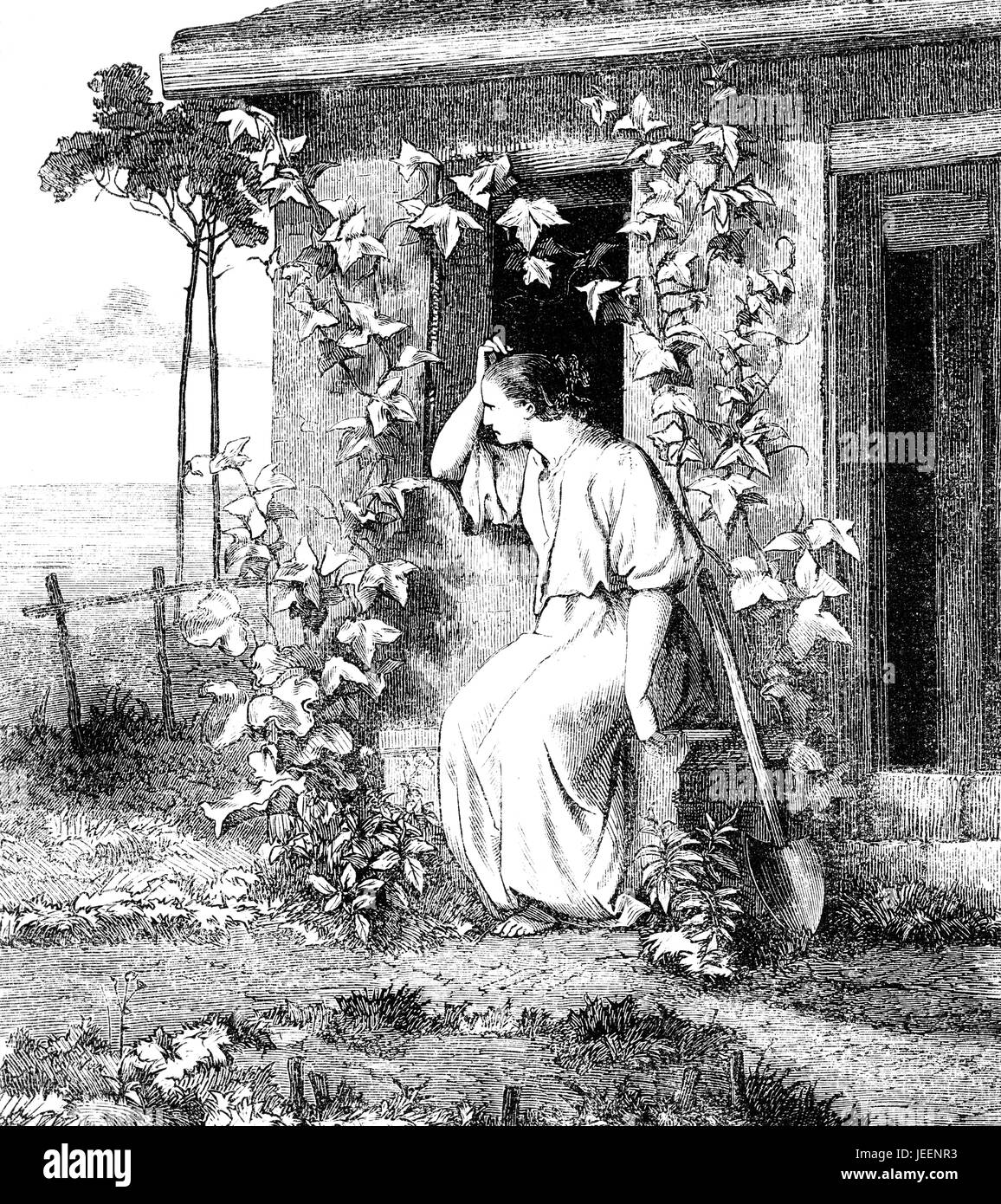 Irene of Athens or Irene Sarantapechaina, c. 752 – 803, a Byzantine empress from 797 to 802, exiled to Lesbos Stock Photohttps://www.alamy.com/image-license-details/?v=1https://www.alamy.com/stock-photo-irene-of-athens-or-irene-sarantapechaina-c-752-803-a-byzantine-empress-146612567.html
Irene of Athens or Irene Sarantapechaina, c. 752 – 803, a Byzantine empress from 797 to 802, exiled to Lesbos Stock Photohttps://www.alamy.com/image-license-details/?v=1https://www.alamy.com/stock-photo-irene-of-athens-or-irene-sarantapechaina-c-752-803-a-byzantine-empress-146612567.htmlRMJEENR3–Irene of Athens or Irene Sarantapechaina, c. 752 – 803, a Byzantine empress from 797 to 802, exiled to Lesbos
 Empress Irene detail from an 11th century mosaic in Hagia Sophia Isanbul Turkey Stock Photohttps://www.alamy.com/image-license-details/?v=1https://www.alamy.com/stock-photo-empress-irene-detail-from-an-11th-century-mosaic-in-hagia-sophia-isanbul-29316804.html
Empress Irene detail from an 11th century mosaic in Hagia Sophia Isanbul Turkey Stock Photohttps://www.alamy.com/image-license-details/?v=1https://www.alamy.com/stock-photo-empress-irene-detail-from-an-11th-century-mosaic-in-hagia-sophia-isanbul-29316804.htmlRMBKKDTM–Empress Irene detail from an 11th century mosaic in Hagia Sophia Isanbul Turkey
 Mosaic of the Virgin Mary and Child, Emperor and Empress of John II, Komnenos and Irene, Byzantine Deesis mosaic, Hagia Sophia, Stock Photohttps://www.alamy.com/image-license-details/?v=1https://www.alamy.com/mosaic-of-the-virgin-mary-and-child-emperor-and-empress-of-john-ii-image61879423.html
Mosaic of the Virgin Mary and Child, Emperor and Empress of John II, Komnenos and Irene, Byzantine Deesis mosaic, Hagia Sophia, Stock Photohttps://www.alamy.com/image-license-details/?v=1https://www.alamy.com/mosaic-of-the-virgin-mary-and-child-emperor-and-empress-of-john-ii-image61879423.htmlRMDGJRRB–Mosaic of the Virgin Mary and Child, Emperor and Empress of John II, Komnenos and Irene, Byzantine Deesis mosaic, Hagia Sophia,
 A Byzantine mosaic of the Virgin and Child between the Emperor John II Comnenus and Empress Irene. Artist: Unknown Stock Photohttps://www.alamy.com/image-license-details/?v=1https://www.alamy.com/a-byzantine-mosaic-of-the-virgin-and-child-between-the-emperor-john-ii-comnenus-and-empress-irene-artist-unknown-image262773340.html
A Byzantine mosaic of the Virgin and Child between the Emperor John II Comnenus and Empress Irene. Artist: Unknown Stock Photohttps://www.alamy.com/image-license-details/?v=1https://www.alamy.com/a-byzantine-mosaic-of-the-virgin-and-child-between-the-emperor-john-ii-comnenus-and-empress-irene-artist-unknown-image262773340.htmlRMW7EA24–A Byzantine mosaic of the Virgin and Child between the Emperor John II Comnenus and Empress Irene. Artist: Unknown
 Byzantine Mosaic or Portrait of Byzantine Empress Irene of Athens (c752-803) reigned 797-802, Holding a Scroll Manuscript in the South Gallery of Hagia Sophia Church Museum, Sultanahmet, Istanbul, Turkey Stock Photohttps://www.alamy.com/image-license-details/?v=1https://www.alamy.com/stock-photo-byzantine-mosaic-or-portrait-of-byzantine-empress-irene-of-athens-172320091.html
Byzantine Mosaic or Portrait of Byzantine Empress Irene of Athens (c752-803) reigned 797-802, Holding a Scroll Manuscript in the South Gallery of Hagia Sophia Church Museum, Sultanahmet, Istanbul, Turkey Stock Photohttps://www.alamy.com/image-license-details/?v=1https://www.alamy.com/stock-photo-byzantine-mosaic-or-portrait-of-byzantine-empress-irene-of-athens-172320091.htmlRMM09T0Y–Byzantine Mosaic or Portrait of Byzantine Empress Irene of Athens (c752-803) reigned 797-802, Holding a Scroll Manuscript in the South Gallery of Hagia Sophia Church Museum, Sultanahmet, Istanbul, Turkey
 Irene von Athen ( ? ), Kaiserin des Byzantinischen Reiches, Kupferstich aus Strahlheim, um 1840 , / Irene of Athens, Byzantine empress, copperplate engraving from Strahlheim, about 1840th . Stock Photohttps://www.alamy.com/image-license-details/?v=1https://www.alamy.com/irene-von-athen-kaiserin-des-byzantinischen-reiches-kupferstich-aus-strahlheim-um-1840-irene-of-athens-byzantine-empress-copperplate-engraving-from-strahlheim-about-1840th-image545785872.html
Irene von Athen ( ? ), Kaiserin des Byzantinischen Reiches, Kupferstich aus Strahlheim, um 1840 , / Irene of Athens, Byzantine empress, copperplate engraving from Strahlheim, about 1840th . Stock Photohttps://www.alamy.com/image-license-details/?v=1https://www.alamy.com/irene-von-athen-kaiserin-des-byzantinischen-reiches-kupferstich-aus-strahlheim-um-1840-irene-of-athens-byzantine-empress-copperplate-engraving-from-strahlheim-about-1840th-image545785872.htmlRM2PKXKCG–Irene von Athen ( ? ), Kaiserin des Byzantinischen Reiches, Kupferstich aus Strahlheim, um 1840 , / Irene of Athens, Byzantine empress, copperplate engraving from Strahlheim, about 1840th .
 Constantine VI (771-804) was the only child of Emperor Leo IV and Empress Irene. He was crowned co-emperor in 776, and became sole emperor in 780, aged only nine. Due to his young age, his mother Irene and her chief minister Staurakios ruled in his stead. However, even when Constantine was of age at sixteen, his mother still refused to hand over executive authority to him. Stock Photohttps://www.alamy.com/image-license-details/?v=1https://www.alamy.com/constantine-vi-771-804-was-the-only-child-of-emperor-leo-iv-and-empress-irene-he-was-crowned-co-emperor-in-776-and-became-sole-emperor-in-780-aged-only-nine-due-to-his-young-age-his-mother-irene-and-her-chief-minister-staurakios-ruled-in-his-stead-however-even-when-constantine-was-of-age-at-sixteen-his-mother-still-refused-to-hand-over-executive-authority-to-him-image344280719.html
Constantine VI (771-804) was the only child of Emperor Leo IV and Empress Irene. He was crowned co-emperor in 776, and became sole emperor in 780, aged only nine. Due to his young age, his mother Irene and her chief minister Staurakios ruled in his stead. However, even when Constantine was of age at sixteen, his mother still refused to hand over executive authority to him. Stock Photohttps://www.alamy.com/image-license-details/?v=1https://www.alamy.com/constantine-vi-771-804-was-the-only-child-of-emperor-leo-iv-and-empress-irene-he-was-crowned-co-emperor-in-776-and-became-sole-emperor-in-780-aged-only-nine-due-to-his-young-age-his-mother-irene-and-her-chief-minister-staurakios-ruled-in-his-stead-however-even-when-constantine-was-of-age-at-sixteen-his-mother-still-refused-to-hand-over-executive-authority-to-him-image344280719.htmlRM2B039FY–Constantine VI (771-804) was the only child of Emperor Leo IV and Empress Irene. He was crowned co-emperor in 776, and became sole emperor in 780, aged only nine. Due to his young age, his mother Irene and her chief minister Staurakios ruled in his stead. However, even when Constantine was of age at sixteen, his mother still refused to hand over executive authority to him.
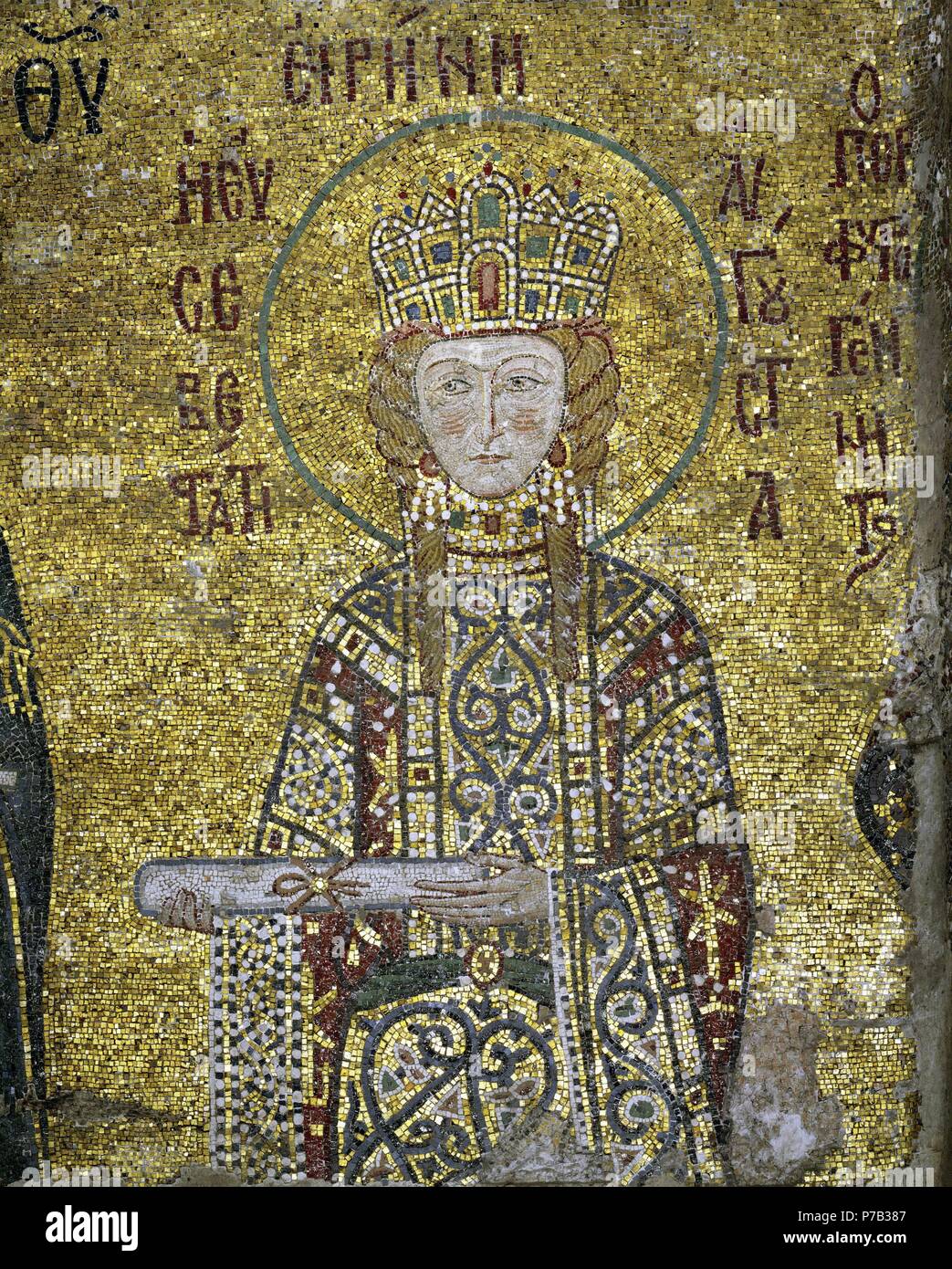 Mosaic of Empress Irene ruled byzantine Empire 1118-43. Haghia Sofia, Istanbul. Stock Photohttps://www.alamy.com/image-license-details/?v=1https://www.alamy.com/mosaic-of-empress-irene-ruled-byzantine-empire-1118-43-haghia-sofia-istanbul-image211071063.html
Mosaic of Empress Irene ruled byzantine Empire 1118-43. Haghia Sofia, Istanbul. Stock Photohttps://www.alamy.com/image-license-details/?v=1https://www.alamy.com/mosaic-of-empress-irene-ruled-byzantine-empire-1118-43-haghia-sofia-istanbul-image211071063.htmlRMP7B387–Mosaic of Empress Irene ruled byzantine Empire 1118-43. Haghia Sofia, Istanbul.
 Constantine VI (771-804) was the only child of Emperor Leo IV and Empress Irene. He was crowned co-emperor in 776, and became sole emperor in 780, aged only nine. Due to his young age, his mother Irene and her chief minister Staurakios ruled in his stead. However, even when Constantine was of age at sixteen, his mother still refused to hand over executive authority to him. Constantine was to marry Rotrude, the daughter of the future Holy Roman Emperor Charlemagne, in 788, but his mother broke off the engagement and instead supported Charlemagne's enemies. When Irene attempted to get official Stock Photohttps://www.alamy.com/image-license-details/?v=1https://www.alamy.com/constantine-vi-771-804-was-the-only-child-of-emperor-leo-iv-and-empress-irene-he-was-crowned-co-emperor-in-776-and-became-sole-emperor-in-780-aged-only-nine-due-to-his-young-age-his-mother-irene-and-her-chief-minister-staurakios-ruled-in-his-stead-however-even-when-constantine-was-of-age-at-sixteen-his-mother-still-refused-to-hand-over-executive-authority-to-him-constantine-was-to-marry-rotrude-the-daughter-of-the-future-holy-roman-emperor-charlemagne-in-788-but-his-mother-broke-off-the-engagement-and-instead-supported-charlemagnes-enemies-when-irene-attempted-to-get-official-image344278852.html
Constantine VI (771-804) was the only child of Emperor Leo IV and Empress Irene. He was crowned co-emperor in 776, and became sole emperor in 780, aged only nine. Due to his young age, his mother Irene and her chief minister Staurakios ruled in his stead. However, even when Constantine was of age at sixteen, his mother still refused to hand over executive authority to him. Constantine was to marry Rotrude, the daughter of the future Holy Roman Emperor Charlemagne, in 788, but his mother broke off the engagement and instead supported Charlemagne's enemies. When Irene attempted to get official Stock Photohttps://www.alamy.com/image-license-details/?v=1https://www.alamy.com/constantine-vi-771-804-was-the-only-child-of-emperor-leo-iv-and-empress-irene-he-was-crowned-co-emperor-in-776-and-became-sole-emperor-in-780-aged-only-nine-due-to-his-young-age-his-mother-irene-and-her-chief-minister-staurakios-ruled-in-his-stead-however-even-when-constantine-was-of-age-at-sixteen-his-mother-still-refused-to-hand-over-executive-authority-to-him-constantine-was-to-marry-rotrude-the-daughter-of-the-future-holy-roman-emperor-charlemagne-in-788-but-his-mother-broke-off-the-engagement-and-instead-supported-charlemagnes-enemies-when-irene-attempted-to-get-official-image344278852.htmlRM2B03758–Constantine VI (771-804) was the only child of Emperor Leo IV and Empress Irene. He was crowned co-emperor in 776, and became sole emperor in 780, aged only nine. Due to his young age, his mother Irene and her chief minister Staurakios ruled in his stead. However, even when Constantine was of age at sixteen, his mother still refused to hand over executive authority to him. Constantine was to marry Rotrude, the daughter of the future Holy Roman Emperor Charlemagne, in 788, but his mother broke off the engagement and instead supported Charlemagne's enemies. When Irene attempted to get official
 John II Comnenos (1087-1143) and Empress Irene (1088-1134). Byzantine emperors. In the centre, the Virgin Mary and Infant Jesus. Stock Photohttps://www.alamy.com/image-license-details/?v=1https://www.alamy.com/stock-photo-john-ii-comnenos-1087-1143-and-empress-irene-1088-1134-byzantine-emperors-39031155.html
John II Comnenos (1087-1143) and Empress Irene (1088-1134). Byzantine emperors. In the centre, the Virgin Mary and Infant Jesus. Stock Photohttps://www.alamy.com/image-license-details/?v=1https://www.alamy.com/stock-photo-john-ii-comnenos-1087-1143-and-empress-irene-1088-1134-byzantine-emperors-39031155.htmlRMC7E0HR–John II Comnenos (1087-1143) and Empress Irene (1088-1134). Byzantine emperors. In the centre, the Virgin Mary and Infant Jesus.
 . Byzantine Empress Irene (image from 'Pala d'Oro', Venice). As there were many Empresses by the name Irene, scholars believe that she was Irene Doukaina. See study here. The inscription says 'ΕΙΡΗΝΗ ΕΥΣΕΒΕΣΤΑΤΗ ΑΥΓΟΥΣΤΗ' (IRENE MOST-RESPECTED AUGUSTI Augustus in female form), not offering any other clue. The enamel of the empress is paired with a plaque similar in size depicting Doge Ordelaffo Falier (both flanking an image of Mary, the mother of God), see in File:Venezia, pala d'oro, madonna tra i donatori irene e l'imperatore Giovanni II Comneno, trasformato nel doge Ordelaffo Falier.JPG, w Stock Photohttps://www.alamy.com/image-license-details/?v=1https://www.alamy.com/byzantine-empress-irene-image-from-pala-doro-venice-as-there-were-many-empresses-by-the-name-irene-scholars-believe-that-she-was-irene-doukaina-see-study-here-the-inscription-says-irene-most-respected-augusti-augustus-in-female-form-not-offering-any-other-clue-the-enamel-of-the-empress-is-paired-with-a-plaque-similar-in-size-depicting-doge-ordelaffo-falier-both-flanking-an-image-of-mary-the-mother-of-god-see-in-filevenezia-pala-doro-madonna-tra-i-donatori-irene-e-limperatore-giovanni-ii-comneno-trasformato-nel-doge-ordelaffo-falierjpg-w-image184775681.html
. Byzantine Empress Irene (image from 'Pala d'Oro', Venice). As there were many Empresses by the name Irene, scholars believe that she was Irene Doukaina. See study here. The inscription says 'ΕΙΡΗΝΗ ΕΥΣΕΒΕΣΤΑΤΗ ΑΥΓΟΥΣΤΗ' (IRENE MOST-RESPECTED AUGUSTI Augustus in female form), not offering any other clue. The enamel of the empress is paired with a plaque similar in size depicting Doge Ordelaffo Falier (both flanking an image of Mary, the mother of God), see in File:Venezia, pala d'oro, madonna tra i donatori irene e l'imperatore Giovanni II Comneno, trasformato nel doge Ordelaffo Falier.JPG, w Stock Photohttps://www.alamy.com/image-license-details/?v=1https://www.alamy.com/byzantine-empress-irene-image-from-pala-doro-venice-as-there-were-many-empresses-by-the-name-irene-scholars-believe-that-she-was-irene-doukaina-see-study-here-the-inscription-says-irene-most-respected-augusti-augustus-in-female-form-not-offering-any-other-clue-the-enamel-of-the-empress-is-paired-with-a-plaque-similar-in-size-depicting-doge-ordelaffo-falier-both-flanking-an-image-of-mary-the-mother-of-god-see-in-filevenezia-pala-doro-madonna-tra-i-donatori-irene-e-limperatore-giovanni-ii-comneno-trasformato-nel-doge-ordelaffo-falierjpg-w-image184775681.htmlRMMMH77D–. Byzantine Empress Irene (image from 'Pala d'Oro', Venice). As there were many Empresses by the name Irene, scholars believe that she was Irene Doukaina. See study here. The inscription says 'ΕΙΡΗΝΗ ΕΥΣΕΒΕΣΤΑΤΗ ΑΥΓΟΥΣΤΗ' (IRENE MOST-RESPECTED AUGUSTI Augustus in female form), not offering any other clue. The enamel of the empress is paired with a plaque similar in size depicting Doge Ordelaffo Falier (both flanking an image of Mary, the mother of God), see in File:Venezia, pala d'oro, madonna tra i donatori irene e l'imperatore Giovanni II Comneno, trasformato nel doge Ordelaffo Falier.JPG, w
 Turkey. Istanbul. Hagia Irene. Byzantine capital with the monogram of Justinian and Theodora. Stock Photohttps://www.alamy.com/image-license-details/?v=1https://www.alamy.com/turkey-istanbul-hagia-irene-byzantine-capital-with-the-monogram-of-image61560491.html
Turkey. Istanbul. Hagia Irene. Byzantine capital with the monogram of Justinian and Theodora. Stock Photohttps://www.alamy.com/image-license-details/?v=1https://www.alamy.com/turkey-istanbul-hagia-irene-byzantine-capital-with-the-monogram-of-image61560491.htmlRMDG490Y–Turkey. Istanbul. Hagia Irene. Byzantine capital with the monogram of Justinian and Theodora.
 Detail of the Comnenus mosaic, Hagia Sophia (Turkish: Ayasofya), Istanbul, Turkey. The Empress Irene of Hungary wearing ceremonial garments and offering a document. Byzantine art. Stock Photohttps://www.alamy.com/image-license-details/?v=1https://www.alamy.com/detail-of-the-comnenus-mosaic-hagia-sophia-turkish-ayasofya-istanbul-turkey-the-empress-irene-of-hungary-wearing-ceremonial-garments-and-offering-a-document-byzantine-art-image431610175.html
Detail of the Comnenus mosaic, Hagia Sophia (Turkish: Ayasofya), Istanbul, Turkey. The Empress Irene of Hungary wearing ceremonial garments and offering a document. Byzantine art. Stock Photohttps://www.alamy.com/image-license-details/?v=1https://www.alamy.com/detail-of-the-comnenus-mosaic-hagia-sophia-turkish-ayasofya-istanbul-turkey-the-empress-irene-of-hungary-wearing-ceremonial-garments-and-offering-a-document-byzantine-art-image431610175.htmlRM2G25F53–Detail of the Comnenus mosaic, Hagia Sophia (Turkish: Ayasofya), Istanbul, Turkey. The Empress Irene of Hungary wearing ceremonial garments and offering a document. Byzantine art.
 religion, christianity, councils, Second Council of Nicaea, 787, session presided by Empress Irene, wood engraving, 19th century Stock Photohttps://www.alamy.com/image-license-details/?v=1https://www.alamy.com/stock-photo-religion-christianity-councils-second-council-of-nicaea-787-session-28627431.html
religion, christianity, councils, Second Council of Nicaea, 787, session presided by Empress Irene, wood engraving, 19th century Stock Photohttps://www.alamy.com/image-license-details/?v=1https://www.alamy.com/stock-photo-religion-christianity-councils-second-council-of-nicaea-787-session-28627431.htmlRMBJG2G7–religion, christianity, councils, Second Council of Nicaea, 787, session presided by Empress Irene, wood engraving, 19th century
 Fresco Emperor John II Komnenos and Empress Irene in Hagia Sophia, Istanbul, Turkey Stock Photohttps://www.alamy.com/image-license-details/?v=1https://www.alamy.com/fresco-emperor-john-ii-komnenos-and-empress-irene-in-hagia-sophia-istanbul-turkey-image337082854.html
Fresco Emperor John II Komnenos and Empress Irene in Hagia Sophia, Istanbul, Turkey Stock Photohttps://www.alamy.com/image-license-details/?v=1https://www.alamy.com/fresco-emperor-john-ii-komnenos-and-empress-irene-in-hagia-sophia-istanbul-turkey-image337082854.htmlRF2AGBCHA–Fresco Emperor John II Komnenos and Empress Irene in Hagia Sophia, Istanbul, Turkey
 Mosaic panel representing Virgin Mary with child Jesus, Emperor Constantine Monomachos and Empress Irene in Hagia Sophia, Istanbul, Turkey Stock Photohttps://www.alamy.com/image-license-details/?v=1https://www.alamy.com/mosaic-panel-representing-virgin-mary-with-child-jesus-emperor-constantine-monomachos-and-empress-irene-in-hagia-sophia-istanbul-turkey-image432987157.html
Mosaic panel representing Virgin Mary with child Jesus, Emperor Constantine Monomachos and Empress Irene in Hagia Sophia, Istanbul, Turkey Stock Photohttps://www.alamy.com/image-license-details/?v=1https://www.alamy.com/mosaic-panel-representing-virgin-mary-with-child-jesus-emperor-constantine-monomachos-and-empress-irene-in-hagia-sophia-istanbul-turkey-image432987157.htmlRF2G4C7F1–Mosaic panel representing Virgin Mary with child Jesus, Emperor Constantine Monomachos and Empress Irene in Hagia Sophia, Istanbul, Turkey
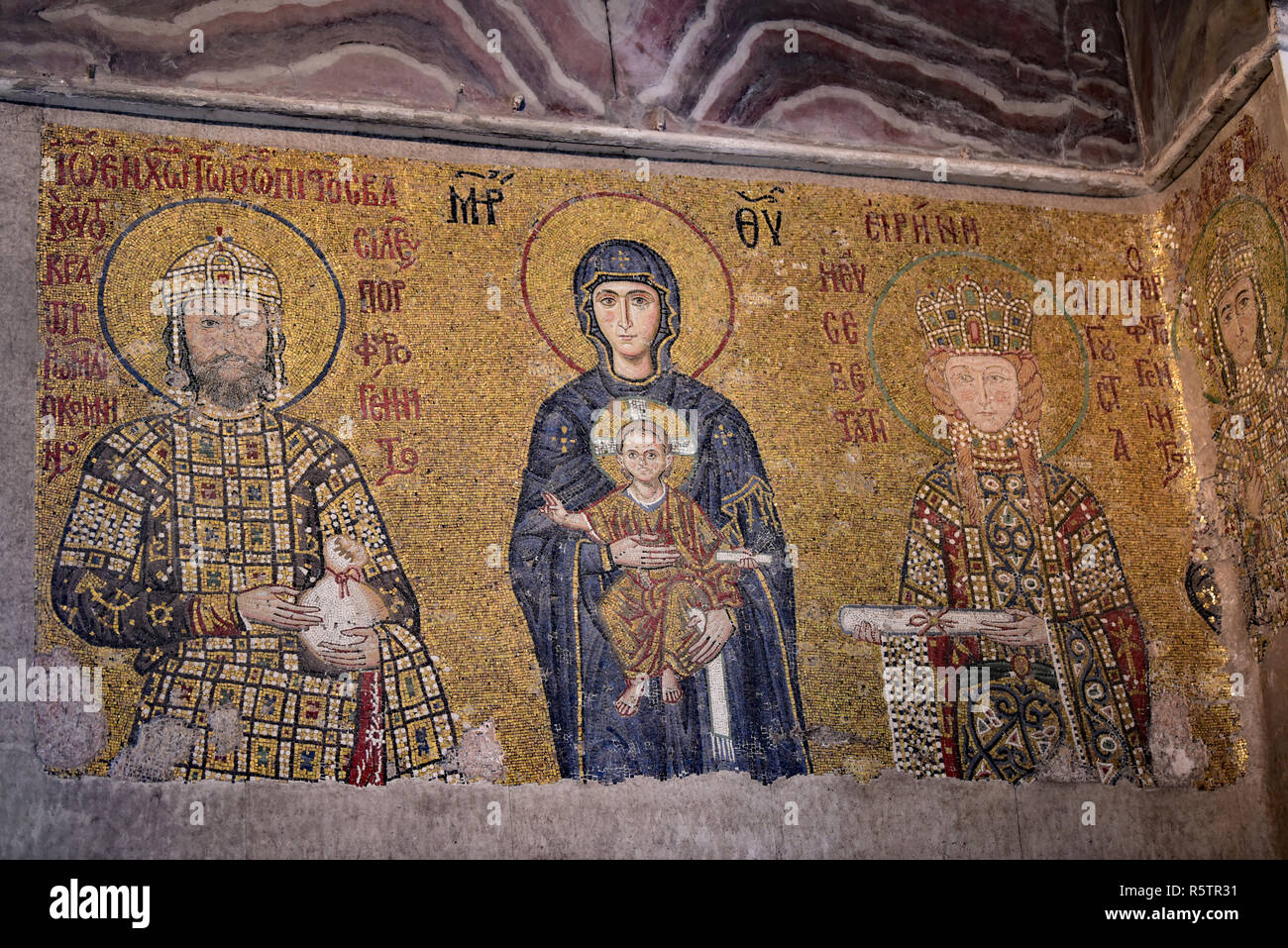 Mosaic of the 'Virgin Mary with Emperor John II Comnenus and Empress Irene' inside the wonderful Haghia Sophia, Sultanahmet, Istanbul, Turkey, Europe. Stock Photohttps://www.alamy.com/image-license-details/?v=1https://www.alamy.com/mosaic-of-the-virgin-mary-with-emperor-john-ii-comnenus-and-empress-irene-inside-the-wonderful-haghia-sophia-sultanahmet-istanbul-turkey-europe-image227353029.html
Mosaic of the 'Virgin Mary with Emperor John II Comnenus and Empress Irene' inside the wonderful Haghia Sophia, Sultanahmet, Istanbul, Turkey, Europe. Stock Photohttps://www.alamy.com/image-license-details/?v=1https://www.alamy.com/mosaic-of-the-virgin-mary-with-emperor-john-ii-comnenus-and-empress-irene-inside-the-wonderful-haghia-sophia-sultanahmet-istanbul-turkey-europe-image227353029.htmlRFR5TR31–Mosaic of the 'Virgin Mary with Emperor John II Comnenus and Empress Irene' inside the wonderful Haghia Sophia, Sultanahmet, Istanbul, Turkey, Europe.
 Turkey Istanbul Basilica of the Hagia Sophia - mosaic - Virgin with child -Emperor John II and Empress Irene XII century - Detail of Empress Irene Stock Photohttps://www.alamy.com/image-license-details/?v=1https://www.alamy.com/stock-image-turkey-istanbul-basilica-of-the-hagia-sophia-mosaic-virgin-with-child-164275973.html
Turkey Istanbul Basilica of the Hagia Sophia - mosaic - Virgin with child -Emperor John II and Empress Irene XII century - Detail of Empress Irene Stock Photohttps://www.alamy.com/image-license-details/?v=1https://www.alamy.com/stock-image-turkey-istanbul-basilica-of-the-hagia-sophia-mosaic-virgin-with-child-164275973.htmlRMKF7BK1–Turkey Istanbul Basilica of the Hagia Sophia - mosaic - Virgin with child -Emperor John II and Empress Irene XII century - Detail of Empress Irene
 Mosaic of Empress Irene holding a scroll, Hagia Sophia, Istanbul, Turkey, Europe Stock Photohttps://www.alamy.com/image-license-details/?v=1https://www.alamy.com/stock-photo-mosaic-of-empress-irene-holding-a-scroll-hagia-sophia-istanbul-turkey-47777058.html
Mosaic of Empress Irene holding a scroll, Hagia Sophia, Istanbul, Turkey, Europe Stock Photohttps://www.alamy.com/image-license-details/?v=1https://www.alamy.com/stock-photo-mosaic-of-empress-irene-holding-a-scroll-hagia-sophia-istanbul-turkey-47777058.htmlRMCNMC3E–Mosaic of Empress Irene holding a scroll, Hagia Sophia, Istanbul, Turkey, Europe
 Irene of Athens or Irene Sarantapechaina, c. 752 – 803, a Byzantine empress from 797 to 802, exiled to Lesbos Stock Photohttps://www.alamy.com/image-license-details/?v=1https://www.alamy.com/stock-photo-irene-of-athens-or-irene-sarantapechaina-c-752-803-a-byzantine-empress-146612570.html
Irene of Athens or Irene Sarantapechaina, c. 752 – 803, a Byzantine empress from 797 to 802, exiled to Lesbos Stock Photohttps://www.alamy.com/image-license-details/?v=1https://www.alamy.com/stock-photo-irene-of-athens-or-irene-sarantapechaina-c-752-803-a-byzantine-empress-146612570.htmlRMJEENR6–Irene of Athens or Irene Sarantapechaina, c. 752 – 803, a Byzantine empress from 797 to 802, exiled to Lesbos
 Hagia Sophia Istanbul Turkey detail of the mosaic of the Virgin Mary John Comnenus and Empress Irene 11th century Stock Photohttps://www.alamy.com/image-license-details/?v=1https://www.alamy.com/stock-photo-hagia-sophia-istanbul-turkey-detail-of-the-mosaic-of-the-virgin-mary-29312844.html
Hagia Sophia Istanbul Turkey detail of the mosaic of the Virgin Mary John Comnenus and Empress Irene 11th century Stock Photohttps://www.alamy.com/image-license-details/?v=1https://www.alamy.com/stock-photo-hagia-sophia-istanbul-turkey-detail-of-the-mosaic-of-the-virgin-mary-29312844.htmlRMBKK8R8–Hagia Sophia Istanbul Turkey detail of the mosaic of the Virgin Mary John Comnenus and Empress Irene 11th century
 Byzantine. Solidus (Coin) of Empress Irene. 797 AD–802 AD. Constantinople. Gold Portraits of important people appear on local currency all around the world. The same was true in ancient Rome, which began producing its first coinage in the late 4th century BC. Early coins depicted the heads of gods and goddesses on the front side, often in profile, while the back depicted animals, natural resources, symbols, and references to historical events. It was not until 44 BC that the portrait of a living person—Julius Caesar—appeared on coins. Thereafter, profile portraits of rulers or other members of Stock Photohttps://www.alamy.com/image-license-details/?v=1https://www.alamy.com/byzantine-solidus-coin-of-empress-irene-797-ad802-ad-constantinople-gold-portraits-of-important-people-appear-on-local-currency-all-around-the-world-the-same-was-true-in-ancient-rome-which-began-producing-its-first-coinage-in-the-late-4th-century-bc-early-coins-depicted-the-heads-of-gods-and-goddesses-on-the-front-side-often-in-profile-while-the-back-depicted-animals-natural-resources-symbols-and-references-to-historical-events-it-was-not-until-44-bc-that-the-portrait-of-a-living-personjulius-caesarappeared-on-coins-thereafter-profile-portraits-of-rulers-or-other-members-of-image337956588.html
Byzantine. Solidus (Coin) of Empress Irene. 797 AD–802 AD. Constantinople. Gold Portraits of important people appear on local currency all around the world. The same was true in ancient Rome, which began producing its first coinage in the late 4th century BC. Early coins depicted the heads of gods and goddesses on the front side, often in profile, while the back depicted animals, natural resources, symbols, and references to historical events. It was not until 44 BC that the portrait of a living person—Julius Caesar—appeared on coins. Thereafter, profile portraits of rulers or other members of Stock Photohttps://www.alamy.com/image-license-details/?v=1https://www.alamy.com/byzantine-solidus-coin-of-empress-irene-797-ad802-ad-constantinople-gold-portraits-of-important-people-appear-on-local-currency-all-around-the-world-the-same-was-true-in-ancient-rome-which-began-producing-its-first-coinage-in-the-late-4th-century-bc-early-coins-depicted-the-heads-of-gods-and-goddesses-on-the-front-side-often-in-profile-while-the-back-depicted-animals-natural-resources-symbols-and-references-to-historical-events-it-was-not-until-44-bc-that-the-portrait-of-a-living-personjulius-caesarappeared-on-coins-thereafter-profile-portraits-of-rulers-or-other-members-of-image337956588.htmlRM2AHR724–Byzantine. Solidus (Coin) of Empress Irene. 797 AD–802 AD. Constantinople. Gold Portraits of important people appear on local currency all around the world. The same was true in ancient Rome, which began producing its first coinage in the late 4th century BC. Early coins depicted the heads of gods and goddesses on the front side, often in profile, while the back depicted animals, natural resources, symbols, and references to historical events. It was not until 44 BC that the portrait of a living person—Julius Caesar—appeared on coins. Thereafter, profile portraits of rulers or other members of
 Leo IV (750-780), also known as Leo the Khazar, was the son of Emperor Constantine V by his first wife, Irene of Khazaria. He became co-emperor in 751, and married a noble Athenian woman also named Irene in 769. Leo became sole emperor in 775 with the death of his father. Constantine VI (771-804) was the only child of Emperor Leo IV and Empress Irene. He was crowned co-emperor in 776, and became sole emperor in 780, aged only nine. Due to his young age, his mother Irene and her chief minister Staurakios ruled in his stead. However, even when Constantine was of age at sixteen, his mother still Stock Photohttps://www.alamy.com/image-license-details/?v=1https://www.alamy.com/leo-iv-750-780-also-known-as-leo-the-khazar-was-the-son-of-emperor-constantine-v-by-his-first-wife-irene-of-khazaria-he-became-co-emperor-in-751-and-married-a-noble-athenian-woman-also-named-irene-in-769-leo-became-sole-emperor-in-775-with-the-death-of-his-father-constantine-vi-771-804-was-the-only-child-of-emperor-leo-iv-and-empress-irene-he-was-crowned-co-emperor-in-776-and-became-sole-emperor-in-780-aged-only-nine-due-to-his-young-age-his-mother-irene-and-her-chief-minister-staurakios-ruled-in-his-stead-however-even-when-constantine-was-of-age-at-sixteen-his-mother-still-image344280744.html
Leo IV (750-780), also known as Leo the Khazar, was the son of Emperor Constantine V by his first wife, Irene of Khazaria. He became co-emperor in 751, and married a noble Athenian woman also named Irene in 769. Leo became sole emperor in 775 with the death of his father. Constantine VI (771-804) was the only child of Emperor Leo IV and Empress Irene. He was crowned co-emperor in 776, and became sole emperor in 780, aged only nine. Due to his young age, his mother Irene and her chief minister Staurakios ruled in his stead. However, even when Constantine was of age at sixteen, his mother still Stock Photohttps://www.alamy.com/image-license-details/?v=1https://www.alamy.com/leo-iv-750-780-also-known-as-leo-the-khazar-was-the-son-of-emperor-constantine-v-by-his-first-wife-irene-of-khazaria-he-became-co-emperor-in-751-and-married-a-noble-athenian-woman-also-named-irene-in-769-leo-became-sole-emperor-in-775-with-the-death-of-his-father-constantine-vi-771-804-was-the-only-child-of-emperor-leo-iv-and-empress-irene-he-was-crowned-co-emperor-in-776-and-became-sole-emperor-in-780-aged-only-nine-due-to-his-young-age-his-mother-irene-and-her-chief-minister-staurakios-ruled-in-his-stead-however-even-when-constantine-was-of-age-at-sixteen-his-mother-still-image344280744.htmlRM2B039GT–Leo IV (750-780), also known as Leo the Khazar, was the son of Emperor Constantine V by his first wife, Irene of Khazaria. He became co-emperor in 751, and married a noble Athenian woman also named Irene in 769. Leo became sole emperor in 775 with the death of his father. Constantine VI (771-804) was the only child of Emperor Leo IV and Empress Irene. He was crowned co-emperor in 776, and became sole emperor in 780, aged only nine. Due to his young age, his mother Irene and her chief minister Staurakios ruled in his stead. However, even when Constantine was of age at sixteen, his mother still
 Mosaic of Empress Irene and Emperor John II Komnenus in Hagia Sofia Stock Photohttps://www.alamy.com/image-license-details/?v=1https://www.alamy.com/mosaic-of-empress-irene-and-emperor-john-ii-komnenus-in-hagia-sofia-image361295873.html
Mosaic of Empress Irene and Emperor John II Komnenus in Hagia Sofia Stock Photohttps://www.alamy.com/image-license-details/?v=1https://www.alamy.com/mosaic-of-empress-irene-and-emperor-john-ii-komnenus-in-hagia-sofia-image361295873.htmlRM2BYPCG1–Mosaic of Empress Irene and Emperor John II Komnenus in Hagia Sofia
 fine arts, religious art, mosaic, Saint Mary with Empress Irene, Hagia Sophia, Istanbul, Artist's Copyright has not to be cleared Stock Photohttps://www.alamy.com/image-license-details/?v=1https://www.alamy.com/stock-photo-fine-arts-religious-art-mosaic-saint-mary-with-empress-irene-hagia-111311456.html
fine arts, religious art, mosaic, Saint Mary with Empress Irene, Hagia Sophia, Istanbul, Artist's Copyright has not to be cleared Stock Photohttps://www.alamy.com/image-license-details/?v=1https://www.alamy.com/stock-photo-fine-arts-religious-art-mosaic-saint-mary-with-empress-irene-hagia-111311456.htmlRMGD2JW4–fine arts, religious art, mosaic, Saint Mary with Empress Irene, Hagia Sophia, Istanbul, Artist's Copyright has not to be cleared
 Istanbul, Türkiye. Hagia Sophia or Church of St. Sophia is located in Eminonu. The Comnenus mosaic dates from 1122. Virgin Mary with Jesus, Emperor John II Comnenus and Empress Irene Stock Photohttps://www.alamy.com/image-license-details/?v=1https://www.alamy.com/istanbul-trkiye-hagia-sophia-or-church-of-st-sophia-is-located-in-eminonu-the-comnenus-mosaic-dates-from-1122-virgin-mary-with-jesus-emperor-john-ii-comnenus-and-empress-irene-image568260496.html
Istanbul, Türkiye. Hagia Sophia or Church of St. Sophia is located in Eminonu. The Comnenus mosaic dates from 1122. Virgin Mary with Jesus, Emperor John II Comnenus and Empress Irene Stock Photohttps://www.alamy.com/image-license-details/?v=1https://www.alamy.com/istanbul-trkiye-hagia-sophia-or-church-of-st-sophia-is-located-in-eminonu-the-comnenus-mosaic-dates-from-1122-virgin-mary-with-jesus-emperor-john-ii-comnenus-and-empress-irene-image568260496.htmlRM2T0EE1M–Istanbul, Türkiye. Hagia Sophia or Church of St. Sophia is located in Eminonu. The Comnenus mosaic dates from 1122. Virgin Mary with Jesus, Emperor John II Comnenus and Empress Irene
 Empress Irene (1088-1134). Byzantine empress. Mosaic of the South Gallery. Hagia Sophia. Istanbul. Turkey. Stock Photohttps://www.alamy.com/image-license-details/?v=1https://www.alamy.com/empress-irene-1088-1134-byzantine-empress-mosaic-of-the-south-gallery-hagia-sophia-istanbul-turkey-image209609057.html
Empress Irene (1088-1134). Byzantine empress. Mosaic of the South Gallery. Hagia Sophia. Istanbul. Turkey. Stock Photohttps://www.alamy.com/image-license-details/?v=1https://www.alamy.com/empress-irene-1088-1134-byzantine-empress-mosaic-of-the-south-gallery-hagia-sophia-istanbul-turkey-image209609057.htmlRMP50EDN–Empress Irene (1088-1134). Byzantine empress. Mosaic of the South Gallery. Hagia Sophia. Istanbul. Turkey.
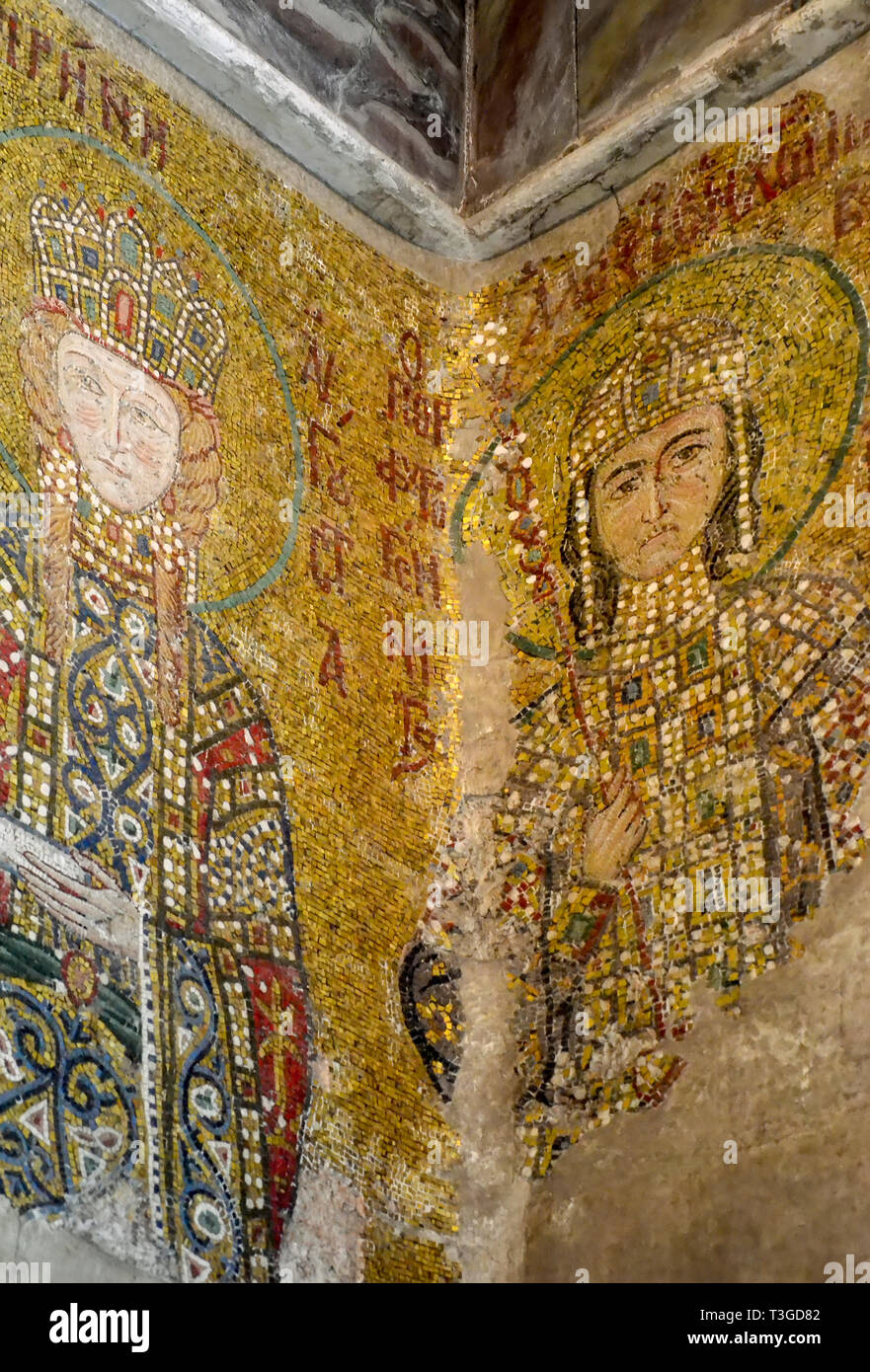 Istanbul, Turkey - September 19 - 2018: Hagia Sophia. Fragment of an ancient Byzantine mosaic depicting Empress Irina and Emperor Alexey Comnenos Stock Photohttps://www.alamy.com/image-license-details/?v=1https://www.alamy.com/istanbul-turkey-september-19-2018-hagia-sophia-fragment-of-an-ancient-byzantine-mosaic-depicting-empress-irina-and-emperor-alexey-comnenos-image243150770.html
Istanbul, Turkey - September 19 - 2018: Hagia Sophia. Fragment of an ancient Byzantine mosaic depicting Empress Irina and Emperor Alexey Comnenos Stock Photohttps://www.alamy.com/image-license-details/?v=1https://www.alamy.com/istanbul-turkey-september-19-2018-hagia-sophia-fragment-of-an-ancient-byzantine-mosaic-depicting-empress-irina-and-emperor-alexey-comnenos-image243150770.htmlRFT3GD82–Istanbul, Turkey - September 19 - 2018: Hagia Sophia. Fragment of an ancient Byzantine mosaic depicting Empress Irina and Emperor Alexey Comnenos
 Mosaic on upper level of Hagia Sophia of Mary with Christ child and Emperor John Comnenus Empress Irene son Elexius Istanbul Turkey Stock Photohttps://www.alamy.com/image-license-details/?v=1https://www.alamy.com/stock-photo-mosaic-on-upper-level-of-hagia-sophia-of-mary-with-christ-child-and-52493877.html
Mosaic on upper level of Hagia Sophia of Mary with Christ child and Emperor John Comnenus Empress Irene son Elexius Istanbul Turkey Stock Photohttps://www.alamy.com/image-license-details/?v=1https://www.alamy.com/stock-photo-mosaic-on-upper-level-of-hagia-sophia-of-mary-with-christ-child-and-52493877.htmlRFD1B8D9–Mosaic on upper level of Hagia Sophia of Mary with Christ child and Emperor John Comnenus Empress Irene son Elexius Istanbul Turkey
 12th century mosaic Virgin Mary and Child, Emperor Johannes Kommenos II (left), and Empress Irene (right) Hagia Sofia Museum in Istanbul Turkey Stock Photohttps://www.alamy.com/image-license-details/?v=1https://www.alamy.com/12th-century-mosaic-virgin-mary-and-child-emperor-johannes-kommenos-image7588776.html
12th century mosaic Virgin Mary and Child, Emperor Johannes Kommenos II (left), and Empress Irene (right) Hagia Sofia Museum in Istanbul Turkey Stock Photohttps://www.alamy.com/image-license-details/?v=1https://www.alamy.com/12th-century-mosaic-virgin-mary-and-child-emperor-johannes-kommenos-image7588776.htmlRMAD27P9–12th century mosaic Virgin Mary and Child, Emperor Johannes Kommenos II (left), and Empress Irene (right) Hagia Sofia Museum in Istanbul Turkey
 Turkey. Istanbul. Hagia Irene. Byzantine capital with the monogram of Justinian and Theodora. Stock Photohttps://www.alamy.com/image-license-details/?v=1https://www.alamy.com/turkey-istanbul-hagia-irene-byzantine-capital-with-the-monogram-of-image61560663.html
Turkey. Istanbul. Hagia Irene. Byzantine capital with the monogram of Justinian and Theodora. Stock Photohttps://www.alamy.com/image-license-details/?v=1https://www.alamy.com/turkey-istanbul-hagia-irene-byzantine-capital-with-the-monogram-of-image61560663.htmlRMDG4973–Turkey. Istanbul. Hagia Irene. Byzantine capital with the monogram of Justinian and Theodora.
 Detail of the Comnenus mosaic, Hagia Sophia (Turkish: Ayasofya), Istanbul, Turkey. The Virgin Mary in a dark blue gown holds the Christ Child on her lap. He gives his blessing with his right hand while holding a scroll in his left. On her right stands emperor John II Comnenus, holding a purse, symbol of an imperial donation to the church. His wife, the empress Irene of Hungary stands opposite wearing ceremonial garments and offering a document. Byzantine art. Stock Photohttps://www.alamy.com/image-license-details/?v=1https://www.alamy.com/detail-of-the-comnenus-mosaic-hagia-sophia-turkish-ayasofya-istanbul-turkey-the-virgin-mary-in-a-dark-blue-gown-holds-the-christ-child-on-her-lap-he-gives-his-blessing-with-his-right-hand-while-holding-a-scroll-in-his-left-on-her-right-stands-emperor-john-ii-comnenus-holding-a-purse-symbol-of-an-imperial-donation-to-the-church-his-wife-the-empress-irene-of-hungary-stands-opposite-wearing-ceremonial-garments-and-offering-a-document-byzantine-art-image431610471.html
Detail of the Comnenus mosaic, Hagia Sophia (Turkish: Ayasofya), Istanbul, Turkey. The Virgin Mary in a dark blue gown holds the Christ Child on her lap. He gives his blessing with his right hand while holding a scroll in his left. On her right stands emperor John II Comnenus, holding a purse, symbol of an imperial donation to the church. His wife, the empress Irene of Hungary stands opposite wearing ceremonial garments and offering a document. Byzantine art. Stock Photohttps://www.alamy.com/image-license-details/?v=1https://www.alamy.com/detail-of-the-comnenus-mosaic-hagia-sophia-turkish-ayasofya-istanbul-turkey-the-virgin-mary-in-a-dark-blue-gown-holds-the-christ-child-on-her-lap-he-gives-his-blessing-with-his-right-hand-while-holding-a-scroll-in-his-left-on-her-right-stands-emperor-john-ii-comnenus-holding-a-purse-symbol-of-an-imperial-donation-to-the-church-his-wife-the-empress-irene-of-hungary-stands-opposite-wearing-ceremonial-garments-and-offering-a-document-byzantine-art-image431610471.htmlRM2G25FFK–Detail of the Comnenus mosaic, Hagia Sophia (Turkish: Ayasofya), Istanbul, Turkey. The Virgin Mary in a dark blue gown holds the Christ Child on her lap. He gives his blessing with his right hand while holding a scroll in his left. On her right stands emperor John II Comnenus, holding a purse, symbol of an imperial donation to the church. His wife, the empress Irene of Hungary stands opposite wearing ceremonial garments and offering a document. Byzantine art.
 Turkey. Istambul. Hagia Sofia. Byzantine mosaic. Virgin Mother holding the Christ Child. Ca, 1118. 12th century. Detail of the mosaic with emperor John II Comnemus, Virgin Mary with the Child Jesus and the empress Irene. Southern gallery. Stock Photohttps://www.alamy.com/image-license-details/?v=1https://www.alamy.com/turkey-istambul-hagia-sofia-byzantine-mosaic-virgin-mother-holding-the-christ-child-ca-1118-12th-century-detail-of-the-mosaic-with-emperor-john-ii-comnemus-virgin-mary-with-the-child-jesus-and-the-empress-irene-southern-gallery-image218505062.html
Turkey. Istambul. Hagia Sofia. Byzantine mosaic. Virgin Mother holding the Christ Child. Ca, 1118. 12th century. Detail of the mosaic with emperor John II Comnemus, Virgin Mary with the Child Jesus and the empress Irene. Southern gallery. Stock Photohttps://www.alamy.com/image-license-details/?v=1https://www.alamy.com/turkey-istambul-hagia-sofia-byzantine-mosaic-virgin-mother-holding-the-christ-child-ca-1118-12th-century-detail-of-the-mosaic-with-emperor-john-ii-comnemus-virgin-mary-with-the-child-jesus-and-the-empress-irene-southern-gallery-image218505062.htmlRMPKDNC6–Turkey. Istambul. Hagia Sofia. Byzantine mosaic. Virgin Mother holding the Christ Child. Ca, 1118. 12th century. Detail of the mosaic with emperor John II Comnemus, Virgin Mary with the Child Jesus and the empress Irene. Southern gallery.
 View of Emperor John II Comnenus, Virgin Mary with Jesus and Empress Irene on Byzantine mosaic in Hagia Sophia,Greek Orthodox Christian patriarchal ba Stock Photohttps://www.alamy.com/image-license-details/?v=1https://www.alamy.com/stock-photo-view-of-emperor-john-ii-comnenus-virgin-mary-with-jesus-and-empress-171873878.html
View of Emperor John II Comnenus, Virgin Mary with Jesus and Empress Irene on Byzantine mosaic in Hagia Sophia,Greek Orthodox Christian patriarchal ba Stock Photohttps://www.alamy.com/image-license-details/?v=1https://www.alamy.com/stock-photo-view-of-emperor-john-ii-comnenus-virgin-mary-with-jesus-and-empress-171873878.htmlRFKYHETP–View of Emperor John II Comnenus, Virgin Mary with Jesus and Empress Irene on Byzantine mosaic in Hagia Sophia,Greek Orthodox Christian patriarchal ba
 Turkey, Istanbul, Sultanahmet, Haghia Sophia mosaic of the Virgin Mary holding the baby Jesus with Emperor and Empress. Stock Photohttps://www.alamy.com/image-license-details/?v=1https://www.alamy.com/stock-photo-turkey-istanbul-sultanahmet-haghia-sophia-mosaic-of-the-virgin-mary-41340715.html
Turkey, Istanbul, Sultanahmet, Haghia Sophia mosaic of the Virgin Mary holding the baby Jesus with Emperor and Empress. Stock Photohttps://www.alamy.com/image-license-details/?v=1https://www.alamy.com/stock-photo-turkey-istanbul-sultanahmet-haghia-sophia-mosaic-of-the-virgin-mary-41340715.htmlRMCB76E3–Turkey, Istanbul, Sultanahmet, Haghia Sophia mosaic of the Virgin Mary holding the baby Jesus with Emperor and Empress.
 The Comnenus mosaic in Hagia Sophia Museum in Istanbul, Turkey Stock Photohttps://www.alamy.com/image-license-details/?v=1https://www.alamy.com/stock-photo-the-comnenus-mosaic-in-hagia-sophia-museum-in-istanbul-turkey-54532809.html
The Comnenus mosaic in Hagia Sophia Museum in Istanbul, Turkey Stock Photohttps://www.alamy.com/image-license-details/?v=1https://www.alamy.com/stock-photo-the-comnenus-mosaic-in-hagia-sophia-museum-in-istanbul-turkey-54532809.htmlRMD4M549–The Comnenus mosaic in Hagia Sophia Museum in Istanbul, Turkey
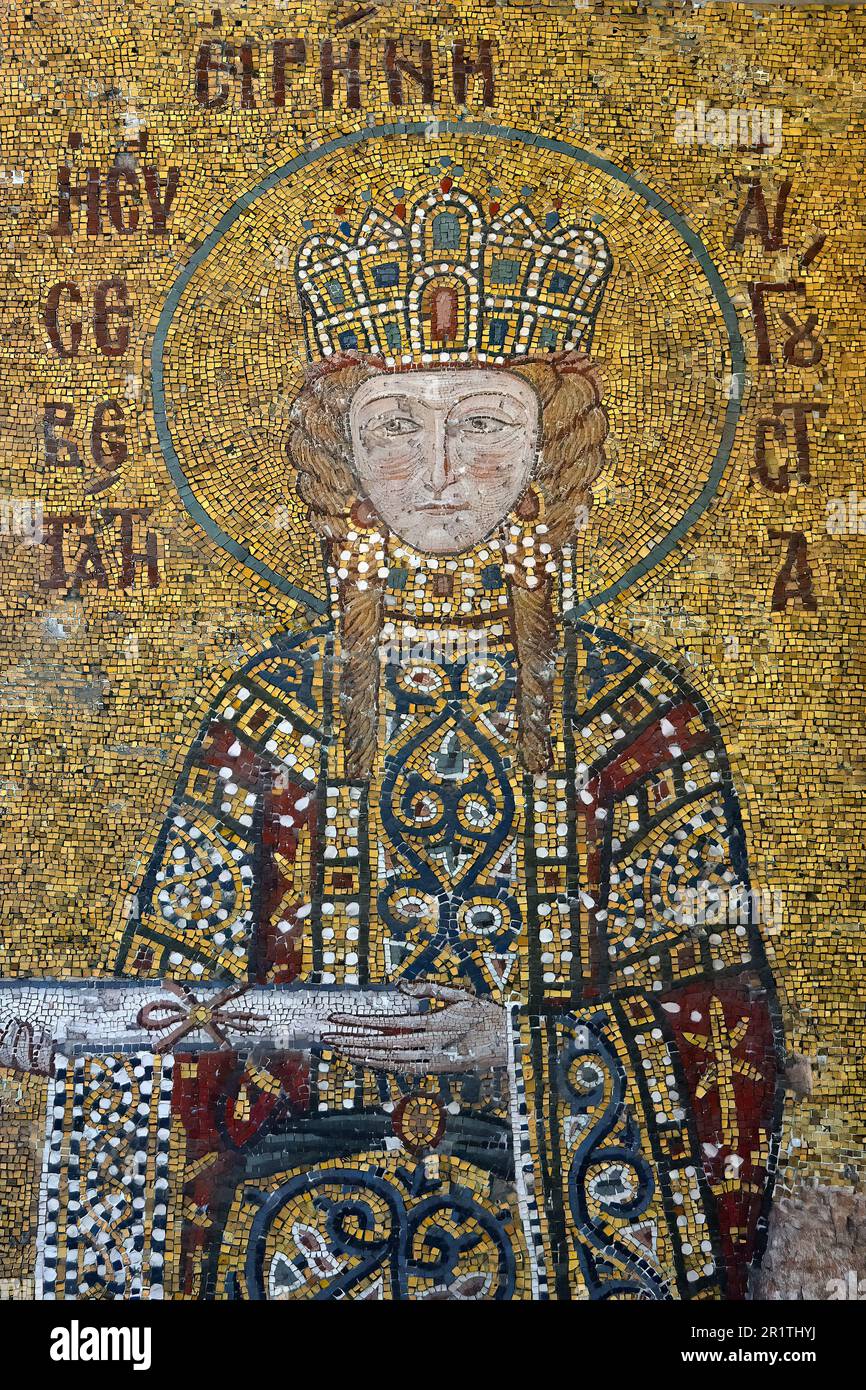 Empress Irene (wife of Emperor John II Komnenos) mosaic, Hagia Sophia, Ayasofya, Hagia Sophia Grand Mosque, Ayasofya Camii, Istanbul, Turkey Stock Photohttps://www.alamy.com/image-license-details/?v=1https://www.alamy.com/empress-irene-wife-of-emperor-john-ii-komnenos-mosaic-hagia-sophia-ayasofya-hagia-sophia-grand-mosque-ayasofya-camii-istanbul-turkey-image551887382.html
Empress Irene (wife of Emperor John II Komnenos) mosaic, Hagia Sophia, Ayasofya, Hagia Sophia Grand Mosque, Ayasofya Camii, Istanbul, Turkey Stock Photohttps://www.alamy.com/image-license-details/?v=1https://www.alamy.com/empress-irene-wife-of-emperor-john-ii-komnenos-mosaic-hagia-sophia-ayasofya-hagia-sophia-grand-mosque-ayasofya-camii-istanbul-turkey-image551887382.htmlRF2R1THYJ–Empress Irene (wife of Emperor John II Komnenos) mosaic, Hagia Sophia, Ayasofya, Hagia Sophia Grand Mosque, Ayasofya Camii, Istanbul, Turkey
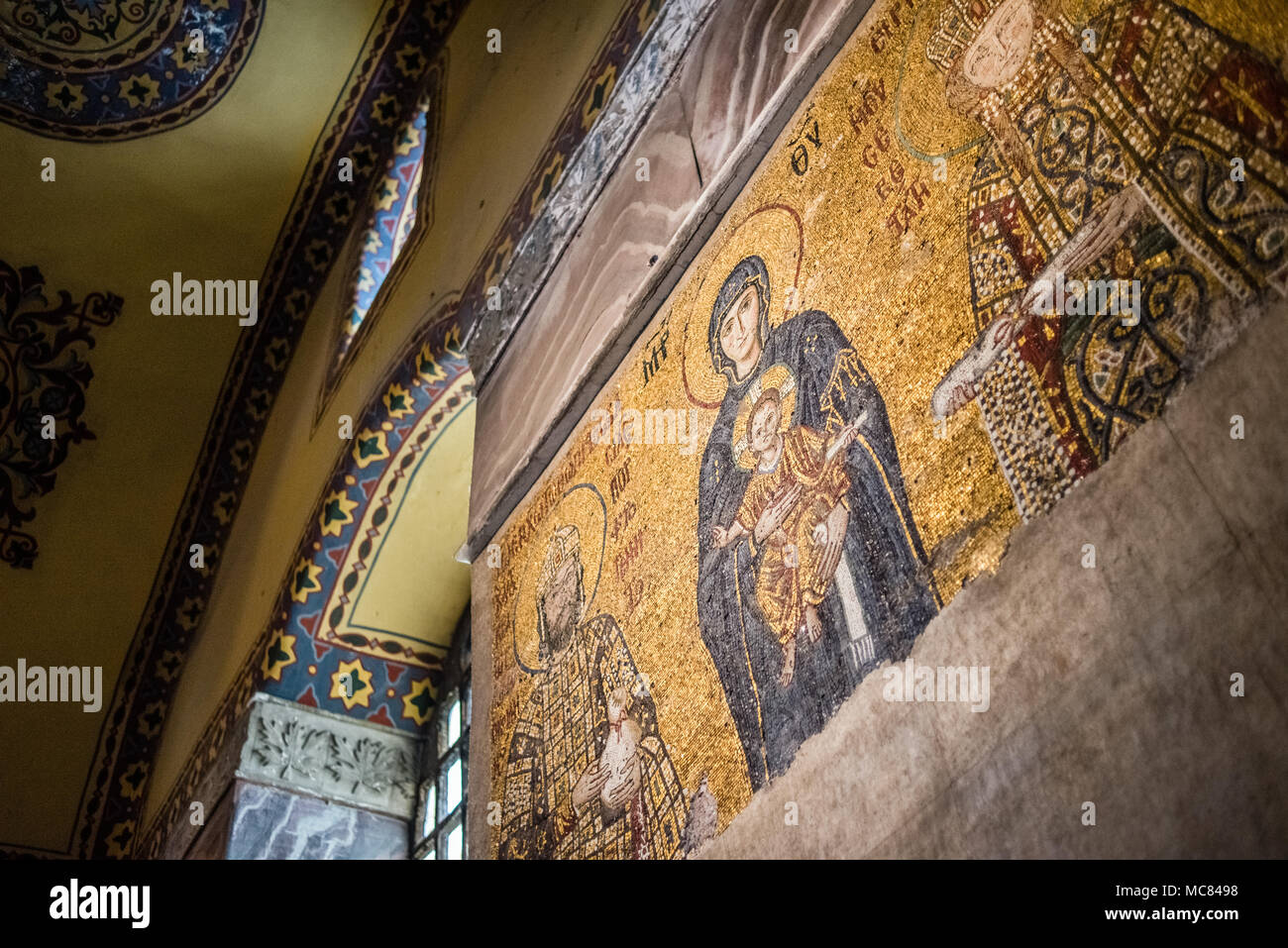 The Comnenus mosaic, Virgin Mary with Jesus, Emperor John II Comnenus and Empress Irene, Hagia Sophia, Istanbul, Turkey Stock Photohttps://www.alamy.com/image-license-details/?v=1https://www.alamy.com/the-comnenus-mosaic-virgin-mary-with-jesus-emperor-john-ii-comnenus-and-empress-irene-hagia-sophia-istanbul-turkey-image179658564.html
The Comnenus mosaic, Virgin Mary with Jesus, Emperor John II Comnenus and Empress Irene, Hagia Sophia, Istanbul, Turkey Stock Photohttps://www.alamy.com/image-license-details/?v=1https://www.alamy.com/the-comnenus-mosaic-virgin-mary-with-jesus-emperor-john-ii-comnenus-and-empress-irene-hagia-sophia-istanbul-turkey-image179658564.htmlRMMC8498–The Comnenus mosaic, Virgin Mary with Jesus, Emperor John II Comnenus and Empress Irene, Hagia Sophia, Istanbul, Turkey
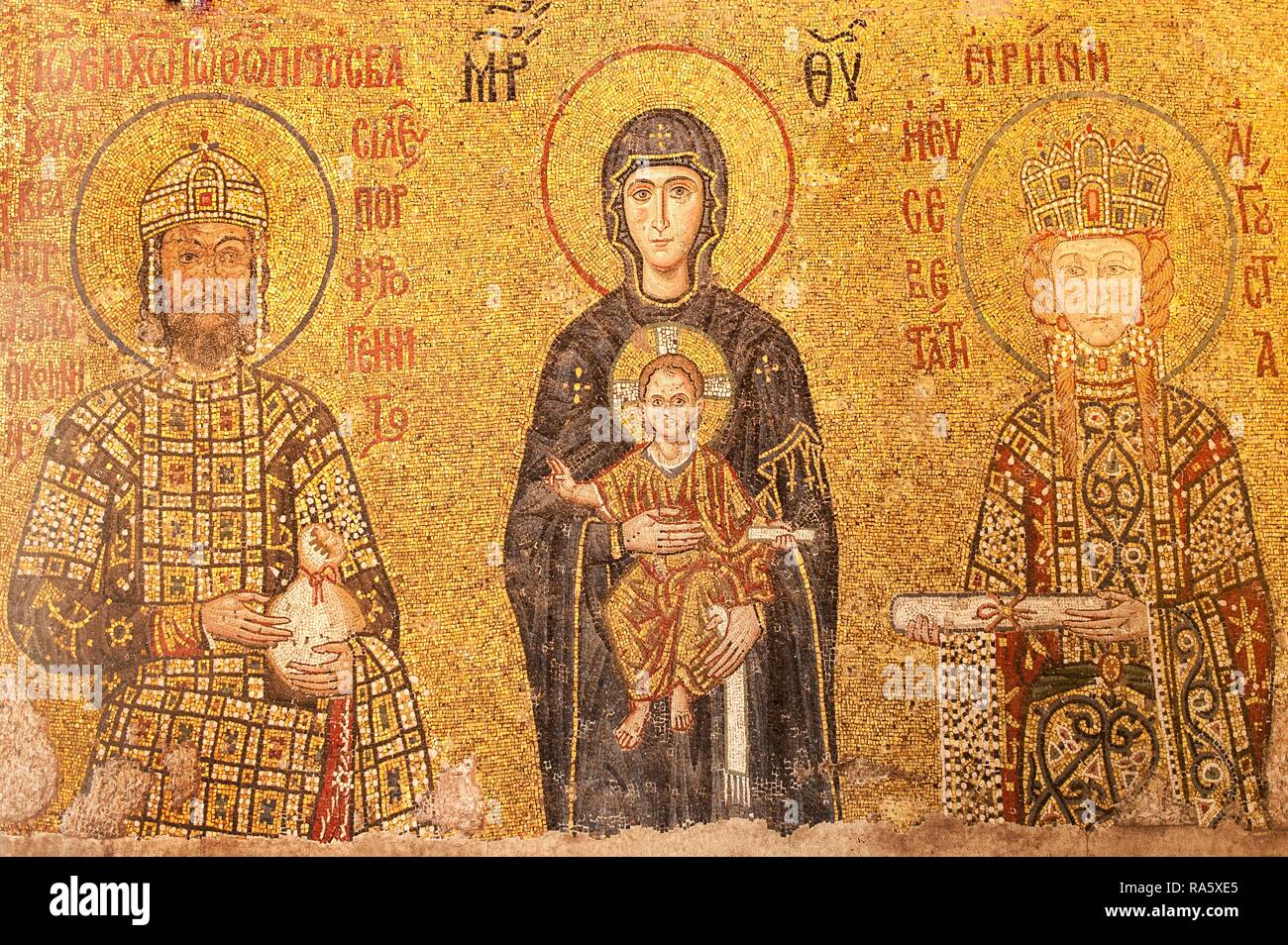 Hagia Sophia, Comnenus Mural mosaic representing the Virgin Mary and Child, the Emperor Johannes Kommenos II and the Empress Stock Photohttps://www.alamy.com/image-license-details/?v=1https://www.alamy.com/hagia-sophia-comnenus-mural-mosaic-representing-the-virgin-mary-and-child-the-emperor-johannes-kommenos-ii-and-the-empress-image230011885.html
Hagia Sophia, Comnenus Mural mosaic representing the Virgin Mary and Child, the Emperor Johannes Kommenos II and the Empress Stock Photohttps://www.alamy.com/image-license-details/?v=1https://www.alamy.com/hagia-sophia-comnenus-mural-mosaic-representing-the-virgin-mary-and-child-the-emperor-johannes-kommenos-ii-and-the-empress-image230011885.htmlRMRA5XE5–Hagia Sophia, Comnenus Mural mosaic representing the Virgin Mary and Child, the Emperor Johannes Kommenos II and the Empress
 Virgin and Child, detail from mosaic with Emperor John Comnenus and Empress Irene, Hagia Sophia, Istanbul, Turkey Stock Photohttps://www.alamy.com/image-license-details/?v=1https://www.alamy.com/stock-photo-virgin-and-child-detail-from-mosaic-with-emperor-john-comnenus-and-29316767.html
Virgin and Child, detail from mosaic with Emperor John Comnenus and Empress Irene, Hagia Sophia, Istanbul, Turkey Stock Photohttps://www.alamy.com/image-license-details/?v=1https://www.alamy.com/stock-photo-virgin-and-child-detail-from-mosaic-with-emperor-john-comnenus-and-29316767.htmlRMBKKDRB–Virgin and Child, detail from mosaic with Emperor John Comnenus and Empress Irene, Hagia Sophia, Istanbul, Turkey
 Istanbul's Hagia Sophia (Greek) or Ayasofya (Turkish) was originally constructed as a main Eastern Orthodox church and served in this role from 537 CE until the fall of Constantinople in 1453 (except between 1204 and 1261 when it was converted by the Fourth Crusaders to a Roman Catholic cathedral). When the Ottoman Turks under Mehmed II conquered Constantinople, the Hagia Sophia was converted into a mosque and Christian relics and art were either removed or plastered over. It remained a mosque for almost 500 years, before being converted into a museum between 1931 and 1935. Famous in particu Stock Photohttps://www.alamy.com/image-license-details/?v=1https://www.alamy.com/istanbuls-hagia-sophia-greek-or-ayasofya-turkish-was-originally-constructed-as-a-main-eastern-orthodox-church-and-served-in-this-role-from-537-ce-until-the-fall-of-constantinople-in-1453-except-between-1204-and-1261-when-it-was-converted-by-the-fourth-crusaders-to-a-roman-catholic-cathedral-when-the-ottoman-turks-under-mehmed-ii-conquered-constantinople-the-hagia-sophia-was-converted-into-a-mosque-and-christian-relics-and-art-were-either-removed-or-plastered-over-it-remained-a-mosque-for-almost-500-years-before-being-converted-into-a-museum-between-1931-and-1935-famous-in-particu-image344276283.html
Istanbul's Hagia Sophia (Greek) or Ayasofya (Turkish) was originally constructed as a main Eastern Orthodox church and served in this role from 537 CE until the fall of Constantinople in 1453 (except between 1204 and 1261 when it was converted by the Fourth Crusaders to a Roman Catholic cathedral). When the Ottoman Turks under Mehmed II conquered Constantinople, the Hagia Sophia was converted into a mosque and Christian relics and art were either removed or plastered over. It remained a mosque for almost 500 years, before being converted into a museum between 1931 and 1935. Famous in particu Stock Photohttps://www.alamy.com/image-license-details/?v=1https://www.alamy.com/istanbuls-hagia-sophia-greek-or-ayasofya-turkish-was-originally-constructed-as-a-main-eastern-orthodox-church-and-served-in-this-role-from-537-ce-until-the-fall-of-constantinople-in-1453-except-between-1204-and-1261-when-it-was-converted-by-the-fourth-crusaders-to-a-roman-catholic-cathedral-when-the-ottoman-turks-under-mehmed-ii-conquered-constantinople-the-hagia-sophia-was-converted-into-a-mosque-and-christian-relics-and-art-were-either-removed-or-plastered-over-it-remained-a-mosque-for-almost-500-years-before-being-converted-into-a-museum-between-1931-and-1935-famous-in-particu-image344276283.htmlRM2B033WF–Istanbul's Hagia Sophia (Greek) or Ayasofya (Turkish) was originally constructed as a main Eastern Orthodox church and served in this role from 537 CE until the fall of Constantinople in 1453 (except between 1204 and 1261 when it was converted by the Fourth Crusaders to a Roman Catholic cathedral). When the Ottoman Turks under Mehmed II conquered Constantinople, the Hagia Sophia was converted into a mosque and Christian relics and art were either removed or plastered over. It remained a mosque for almost 500 years, before being converted into a museum between 1931 and 1935. Famous in particu
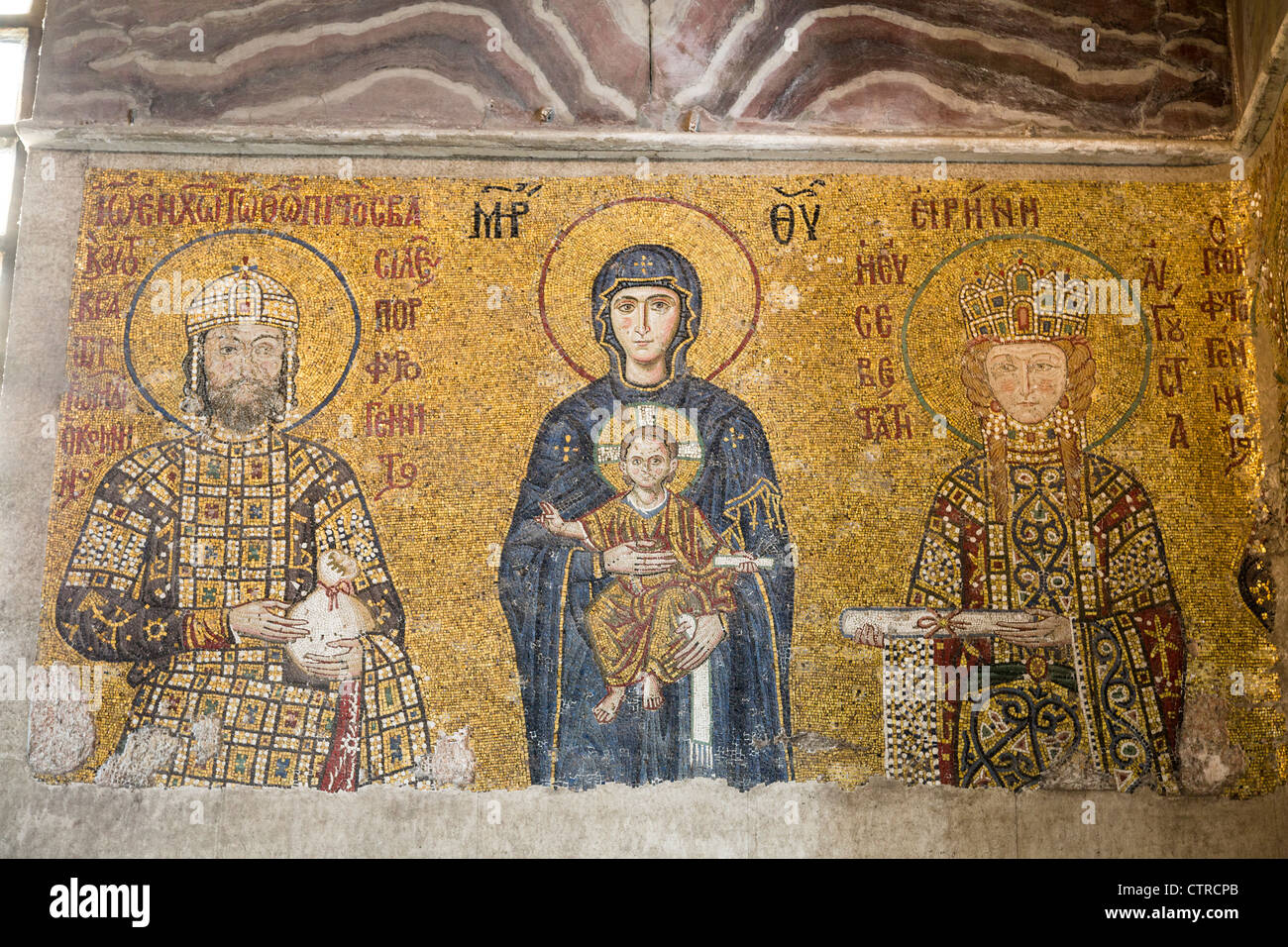 Comnenus mosaics, Haghia Sophia, Istanbul, Turkey Stock Photohttps://www.alamy.com/image-license-details/?v=1https://www.alamy.com/stock-photo-comnenus-mosaics-haghia-sophia-istanbul-turkey-49687411.html
Comnenus mosaics, Haghia Sophia, Istanbul, Turkey Stock Photohttps://www.alamy.com/image-license-details/?v=1https://www.alamy.com/stock-photo-comnenus-mosaics-haghia-sophia-istanbul-turkey-49687411.htmlRMCTRCPB–Comnenus mosaics, Haghia Sophia, Istanbul, Turkey
 The Comnenus mosaic in Hagia Sophia Museum, Istanbul, Turkey Stock Photohttps://www.alamy.com/image-license-details/?v=1https://www.alamy.com/stock-photo-the-comnenus-mosaic-in-hagia-sophia-museum-istanbul-turkey-37899233.html
The Comnenus mosaic in Hagia Sophia Museum, Istanbul, Turkey Stock Photohttps://www.alamy.com/image-license-details/?v=1https://www.alamy.com/stock-photo-the-comnenus-mosaic-in-hagia-sophia-museum-istanbul-turkey-37899233.htmlRMC5JCT1–The Comnenus mosaic in Hagia Sophia Museum, Istanbul, Turkey
 Comnenus mosaics in Hagia Sophia former Orthodox patriarchal basilica, Istanbul. Stock Photohttps://www.alamy.com/image-license-details/?v=1https://www.alamy.com/stock-photo-comnenus-mosaics-in-hagia-sophia-former-orthodox-patriarchal-basilica-35799801.html
Comnenus mosaics in Hagia Sophia former Orthodox patriarchal basilica, Istanbul. Stock Photohttps://www.alamy.com/image-license-details/?v=1https://www.alamy.com/stock-photo-comnenus-mosaics-in-hagia-sophia-former-orthodox-patriarchal-basilica-35799801.htmlRMC26R09–Comnenus mosaics in Hagia Sophia former Orthodox patriarchal basilica, Istanbul.
 John II Comnenos (1087-1143) and Empress Irene (1088-1134). Byzantine emperors. In the centre, the Virgin Mary and Infant Jesus. Mosaic of the South Gallery. Hagia Sophia. Istanbul. Turkey. Stock Photohttps://www.alamy.com/image-license-details/?v=1https://www.alamy.com/john-ii-comnenos-1087-1143-and-empress-irene-1088-1134-byzantine-emperors-in-the-centre-the-virgin-mary-and-infant-jesus-mosaic-of-the-south-gallery-hagia-sophia-istanbul-turkey-image231202064.html
John II Comnenos (1087-1143) and Empress Irene (1088-1134). Byzantine emperors. In the centre, the Virgin Mary and Infant Jesus. Mosaic of the South Gallery. Hagia Sophia. Istanbul. Turkey. Stock Photohttps://www.alamy.com/image-license-details/?v=1https://www.alamy.com/john-ii-comnenos-1087-1143-and-empress-irene-1088-1134-byzantine-emperors-in-the-centre-the-virgin-mary-and-infant-jesus-mosaic-of-the-south-gallery-hagia-sophia-istanbul-turkey-image231202064.htmlRMRC44GG–John II Comnenos (1087-1143) and Empress Irene (1088-1134). Byzantine emperors. In the centre, the Virgin Mary and Infant Jesus. Mosaic of the South Gallery. Hagia Sophia. Istanbul. Turkey.
 View of Emperor John II Comnenus, Virgin Mary with Jesus and Empress Irene on Byzantine mosaic in Hagia Sophia,Greek Orthodox Christian patriarchal ba Stock Photohttps://www.alamy.com/image-license-details/?v=1https://www.alamy.com/stock-photo-view-of-emperor-john-ii-comnenus-virgin-mary-with-jesus-and-empress-171873856.html
View of Emperor John II Comnenus, Virgin Mary with Jesus and Empress Irene on Byzantine mosaic in Hagia Sophia,Greek Orthodox Christian patriarchal ba Stock Photohttps://www.alamy.com/image-license-details/?v=1https://www.alamy.com/stock-photo-view-of-emperor-john-ii-comnenus-virgin-mary-with-jesus-and-empress-171873856.htmlRFKYHET0–View of Emperor John II Comnenus, Virgin Mary with Jesus and Empress Irene on Byzantine mosaic in Hagia Sophia,Greek Orthodox Christian patriarchal ba
 The Comnenus mosaic, Virgin Mary with Jesus, Emperor John II Comnenus and Empress Irene, Hagia Sophia, Istanbul, Turkey Stock Photohttps://www.alamy.com/image-license-details/?v=1https://www.alamy.com/the-comnenus-mosaic-virgin-mary-with-jesus-emperor-john-ii-comnenus-and-empress-irene-hagia-sophia-istanbul-turkey-image179658565.html
The Comnenus mosaic, Virgin Mary with Jesus, Emperor John II Comnenus and Empress Irene, Hagia Sophia, Istanbul, Turkey Stock Photohttps://www.alamy.com/image-license-details/?v=1https://www.alamy.com/the-comnenus-mosaic-virgin-mary-with-jesus-emperor-john-ii-comnenus-and-empress-irene-hagia-sophia-istanbul-turkey-image179658565.htmlRMMC8499–The Comnenus mosaic, Virgin Mary with Jesus, Emperor John II Comnenus and Empress Irene, Hagia Sophia, Istanbul, Turkey
 Emperor John Comnenus, detail from the mosaic of the Virgin and Empress Irene, 1118 AD Hagia Sophia, Istanbul, Turkey Stock Photohttps://www.alamy.com/image-license-details/?v=1https://www.alamy.com/stock-photo-emperor-john-comnenus-detail-from-the-mosaic-of-the-virgin-and-empress-29312969.html
Emperor John Comnenus, detail from the mosaic of the Virgin and Empress Irene, 1118 AD Hagia Sophia, Istanbul, Turkey Stock Photohttps://www.alamy.com/image-license-details/?v=1https://www.alamy.com/stock-photo-emperor-john-comnenus-detail-from-the-mosaic-of-the-virgin-and-empress-29312969.htmlRMBKK8YN–Emperor John Comnenus, detail from the mosaic of the Virgin and Empress Irene, 1118 AD Hagia Sophia, Istanbul, Turkey
 Comnenus mosaics in Hagia Sophia former Orthodox patriarchal basilica, Istanbul. Stock Photohttps://www.alamy.com/image-license-details/?v=1https://www.alamy.com/stock-photo-comnenus-mosaics-in-hagia-sophia-former-orthodox-patriarchal-basilica-35799794.html
Comnenus mosaics in Hagia Sophia former Orthodox patriarchal basilica, Istanbul. Stock Photohttps://www.alamy.com/image-license-details/?v=1https://www.alamy.com/stock-photo-comnenus-mosaics-in-hagia-sophia-former-orthodox-patriarchal-basilica-35799794.htmlRMC26R02–Comnenus mosaics in Hagia Sophia former Orthodox patriarchal basilica, Istanbul.
 Solidus (Coin) of Empress Irene. Byzantine, minted in Constantinople. Date: 797 AD-802 AD. Dimensions: Diam. 2.2 cm; 4.46 g. Gold. Origin: Constantinople. Museum: The Chicago Art Institute. Stock Photohttps://www.alamy.com/image-license-details/?v=1https://www.alamy.com/solidus-coin-of-empress-irene-byzantine-minted-in-constantinople-date-797-ad-802-ad-dimensions-diam-22-cm-446-g-gold-origin-constantinople-museum-the-chicago-art-institute-image239883917.html
Solidus (Coin) of Empress Irene. Byzantine, minted in Constantinople. Date: 797 AD-802 AD. Dimensions: Diam. 2.2 cm; 4.46 g. Gold. Origin: Constantinople. Museum: The Chicago Art Institute. Stock Photohttps://www.alamy.com/image-license-details/?v=1https://www.alamy.com/solidus-coin-of-empress-irene-byzantine-minted-in-constantinople-date-797-ad-802-ad-dimensions-diam-22-cm-446-g-gold-origin-constantinople-museum-the-chicago-art-institute-image239883917.htmlRMRX7JAN–Solidus (Coin) of Empress Irene. Byzantine, minted in Constantinople. Date: 797 AD-802 AD. Dimensions: Diam. 2.2 cm; 4.46 g. Gold. Origin: Constantinople. Museum: The Chicago Art Institute.
 Comnenus mosaics in Hagia Sophia former Orthodox patriarchal basilica, Istanbul. Stock Photohttps://www.alamy.com/image-license-details/?v=1https://www.alamy.com/stock-photo-comnenus-mosaics-in-hagia-sophia-former-orthodox-patriarchal-basilica-35799798.html
Comnenus mosaics in Hagia Sophia former Orthodox patriarchal basilica, Istanbul. Stock Photohttps://www.alamy.com/image-license-details/?v=1https://www.alamy.com/stock-photo-comnenus-mosaics-in-hagia-sophia-former-orthodox-patriarchal-basilica-35799798.htmlRMC26R06–Comnenus mosaics in Hagia Sophia former Orthodox patriarchal basilica, Istanbul.
 Turkey. Istambul. Hagia Sofia. Byzantine mosaic. Virgin Mother holding the Christ Child. Ca, 1118. 12th century. Detail of the mosaic with emperor John II Comnemus, Virgin Mary with the Child Jesus and the empress Irene. Southern gallery. Stock Photohttps://www.alamy.com/image-license-details/?v=1https://www.alamy.com/turkey-istambul-hagia-sofia-byzantine-mosaic-virgin-mother-holding-the-christ-child-ca-1118-12th-century-detail-of-the-mosaic-with-emperor-john-ii-comnemus-virgin-mary-with-the-child-jesus-and-the-empress-irene-southern-gallery-image219995948.html
Turkey. Istambul. Hagia Sofia. Byzantine mosaic. Virgin Mother holding the Christ Child. Ca, 1118. 12th century. Detail of the mosaic with emperor John II Comnemus, Virgin Mary with the Child Jesus and the empress Irene. Southern gallery. Stock Photohttps://www.alamy.com/image-license-details/?v=1https://www.alamy.com/turkey-istambul-hagia-sofia-byzantine-mosaic-virgin-mother-holding-the-christ-child-ca-1118-12th-century-detail-of-the-mosaic-with-emperor-john-ii-comnemus-virgin-mary-with-the-child-jesus-and-the-empress-irene-southern-gallery-image219995948.htmlRMPNWK24–Turkey. Istambul. Hagia Sofia. Byzantine mosaic. Virgin Mother holding the Christ Child. Ca, 1118. 12th century. Detail of the mosaic with emperor John II Comnemus, Virgin Mary with the Child Jesus and the empress Irene. Southern gallery.
 Portrait of Empress Irene. Museum: Hagia Sophia, Istanbul, Turkey. Stock Photohttps://www.alamy.com/image-license-details/?v=1https://www.alamy.com/portrait-of-empress-irene-museum-hagia-sophia-istanbul-turkey-image211751160.html
Portrait of Empress Irene. Museum: Hagia Sophia, Istanbul, Turkey. Stock Photohttps://www.alamy.com/image-license-details/?v=1https://www.alamy.com/portrait-of-empress-irene-museum-hagia-sophia-istanbul-turkey-image211751160.htmlRMP8E2NC–Portrait of Empress Irene. Museum: Hagia Sophia, Istanbul, Turkey.
 Turkey. Istanbul. Hagia Irene. Byzantine capital with the monogram of Justinian and Theodora. Stock Photohttps://www.alamy.com/image-license-details/?v=1https://www.alamy.com/turkey-istanbul-hagia-irene-byzantine-capital-with-the-monogram-of-justinian-and-theodora-image209710620.html
Turkey. Istanbul. Hagia Irene. Byzantine capital with the monogram of Justinian and Theodora. Stock Photohttps://www.alamy.com/image-license-details/?v=1https://www.alamy.com/turkey-istanbul-hagia-irene-byzantine-capital-with-the-monogram-of-justinian-and-theodora-image209710620.htmlRMP55410–Turkey. Istanbul. Hagia Irene. Byzantine capital with the monogram of Justinian and Theodora.
 Turkey. Istanbul. Hagia Irene. Byzantine capital with the monogram of Justinian and Theodora. Stock Photohttps://www.alamy.com/image-license-details/?v=1https://www.alamy.com/turkey-istanbul-hagia-irene-byzantine-capital-with-the-monogram-of-justinian-and-theodora-image209710622.html
Turkey. Istanbul. Hagia Irene. Byzantine capital with the monogram of Justinian and Theodora. Stock Photohttps://www.alamy.com/image-license-details/?v=1https://www.alamy.com/turkey-istanbul-hagia-irene-byzantine-capital-with-the-monogram-of-justinian-and-theodora-image209710622.htmlRMP55412–Turkey. Istanbul. Hagia Irene. Byzantine capital with the monogram of Justinian and Theodora.
 IRENE DUCAS EMPERATRIZ DE ORIENTE 1066-1123 - MOSAICO BIZANTINO - SIGLO XII. Location: SANTA SOFIA DE CONSTANTINOPLA, ISTANBUL, TURQUIA. Stock Photohttps://www.alamy.com/image-license-details/?v=1https://www.alamy.com/irene-ducas-emperatriz-de-oriente-1066-1123-mosaico-bizantino-siglo-xii-location-santa-sofia-de-constantinopla-istanbul-turquia-image208963989.html
IRENE DUCAS EMPERATRIZ DE ORIENTE 1066-1123 - MOSAICO BIZANTINO - SIGLO XII. Location: SANTA SOFIA DE CONSTANTINOPLA, ISTANBUL, TURQUIA. Stock Photohttps://www.alamy.com/image-license-details/?v=1https://www.alamy.com/irene-ducas-emperatriz-de-oriente-1066-1123-mosaico-bizantino-siglo-xii-location-santa-sofia-de-constantinopla-istanbul-turquia-image208963989.htmlRMP3Y3KH–IRENE DUCAS EMPERATRIZ DE ORIENTE 1066-1123 - MOSAICO BIZANTINO - SIGLO XII. Location: SANTA SOFIA DE CONSTANTINOPLA, ISTANBUL, TURQUIA.
 ARTE BIZANTINO. TURQUIA. Mosaico con la representación de la EMPERATRIZ IRENE, esposa de Juan II Comneno (s. XI). Localizado en la galería meridional de la BASILICA DE SANTA SOFIA. ESTAMBUL. Turquía. Stock Photohttps://www.alamy.com/image-license-details/?v=1https://www.alamy.com/arte-bizantino-turquia-mosaico-con-la-representacin-de-la-emperatriz-irene-esposa-de-juan-ii-comneno-s-xi-localizado-en-la-galera-meridional-de-la-basilica-de-santa-sofia-estambul-turqua-image209677941.html
ARTE BIZANTINO. TURQUIA. Mosaico con la representación de la EMPERATRIZ IRENE, esposa de Juan II Comneno (s. XI). Localizado en la galería meridional de la BASILICA DE SANTA SOFIA. ESTAMBUL. Turquía. Stock Photohttps://www.alamy.com/image-license-details/?v=1https://www.alamy.com/arte-bizantino-turquia-mosaico-con-la-representacin-de-la-emperatriz-irene-esposa-de-juan-ii-comneno-s-xi-localizado-en-la-galera-meridional-de-la-basilica-de-santa-sofia-estambul-turqua-image209677941.htmlRMP53J9W–ARTE BIZANTINO. TURQUIA. Mosaico con la representación de la EMPERATRIZ IRENE, esposa de Juan II Comneno (s. XI). Localizado en la galería meridional de la BASILICA DE SANTA SOFIA. ESTAMBUL. Turquía.